Greece 2023: Margaret's Travel Log
An account of a Journey with a Motorhome, two Bicycles and two Ferries from England to the Greek Peloponnese through the Netherlands, Germany, Switzerland and Italy
Friday, 24 February 2023
Day One 186 miles
Hook of Holland to Camping Heider Bergsee, Brühl, Nordrhein-Westfalen, Germany
Click: 26 Photographs of the Overnight Ferry from Ancona to Patras
At the Hook of Holland we disembarked the Stena Hollandica night ferry from Harwich promptly at 8 am local time. In our splendid outside cabin equipped with fridge, kettle, hot and cold drinks, snacks and chocolate, we’d already broken our fast with tea and biscuits. After a brief stamping of passports, we followed the satnav across the outskirts of Rotterdam on a constantly changing countdown of N-roads and motorways, through the Benelux Tunnel under the Maas (part of the Rhine delta), southeast past Dordrecht and Moerdijk to Breda, east by Tilbury and Eindhoven, to cross into Germany near Venlo after 127 miles of orderly toll-free driving. Passing from one Schengen country into another without a moment’s delay.
Day One 186 miles
Hook of Holland to Camping Heider Bergsee, Brühl, Nordrhein-Westfalen, Germany
Click: 26 Photographs of the Overnight Ferry from Ancona to Patras
At the Hook of Holland we disembarked the Stena Hollandica night ferry from Harwich promptly at 8 am local time. In our splendid outside cabin equipped with fridge, kettle, hot and cold drinks, snacks and chocolate, we’d already broken our fast with tea and biscuits. After a brief stamping of passports, we followed the satnav across the outskirts of Rotterdam on a constantly changing countdown of N-roads and motorways, through the Benelux Tunnel under the Maas (part of the Rhine delta), southeast past Dordrecht and Moerdijk to Breda, east by Tilbury and Eindhoven, to cross into Germany near Venlo after 127 miles of orderly toll-free driving. Passing from one Schengen country into another without a moment’s delay.
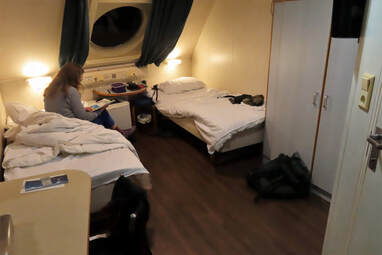
The lakeside campsite near Cologne was just 6 miles from the A61 motorway (exit 108). With Reception closed for Mittagspause till 3 pm (a relentless German custom), we waited for an hour in the rain until the grumpy custodian showed us to a sloping pitch on the small touring area. The site restaurant was closed, the washing machine out of order and the ‘free’ WiFi didn’t connect, but we were glad of the 16-amp hook-up to get warm, cook supper and watch a DVD film. At least we were on our way to Greece, with one week to reach the next ferry. Our enforced Schengen countdown had begun.
Day Two 218 miles
Brühl to Camping am Achernsee, Achern, Baden-Württemberg, Germany
The A61 climbed south through the Eifel hills and vineyards of the Ahr Valley, across the Mosel bridge near Koblenz at a height of 600 m/2000 ft, and on through more vine-clad slopes along the Nahe Valley towards Mainz and Ludwigshafen. After stopping at the services for a Burger King lunch (perhaps fit for a Burger but not for a King!) we crossed the Rhine near Hockenheim, home of German motor racing, for which drivers obviously practise on the Autobahns. Then onto the A5 until exit 53 for another lakeside campsite just 2 miles away near Achern. Again, the site was mainly permanent caravans with a small grassy touring area, soft and muddy after yesterday’s rain. At least the ‘free’ WiFi was working, though the antiquated transponder for hot showers didn’t function, to my annoyance. (It transpired next morning that Herr Campingplatzführer had set the wrong date on it!) The outside temperature dropped to -1°C overnight.
Day Three 175 miles
Achern, Germany to Camping Remo Moosbad, Altdorf, Switzerland
A fill of diesel at the Autohof (truckstop - cheaper than motorway services) before rejoining the A5 running south between the Black Forest and the Rhine. It was 89 miles to the Swiss border at Weil am Rhein, where the guard checked our passports and sold us a Swiss vignette sticker for 40 CHF (Swiss Francs, approx 40 Euros) with a swipe of a bank card. Good value: valid to the end of 2023 covering all Swiss motorways and tunnels. There was not a glimpse of the Rhine as we drove through Basel in a series of tunnels, eventually gaining the A2/E25 signed for Luzern, Gotthard and Chiasso at the Italian border. By noon it was trying to snow as we climbed above 500 m/1650 ft. Lunch break in a Rastplatz by the Sursee Lake: one of several such civilised rest areas with 4 charging points for e-cars, WC, picnic tables, hot/cold drinks machine and a 2-hour limit for trucks. After bypassing Luzern through more tunnels we took exit 36 for Altdorf, less than a mile from Remo Camping next to the cable car station. The German-speaking receptionist gave a warm welcome, supplying a couple of Swiss Francs for the showers. The camping bill could be settled in Euros, Francs or bank card, so no local currency was needed. The site was mostly permanent caravans with a small touring area, excellent heated facilities and free WiFi that worked.
We spent a second day here, breaking the journey with a morning’s writing and a chilly 10-minute afternoon walk along the river into Altdorf (a well-named Old Village). This was the site of Wilhelm Tell’s legendary shot at the apple on his son’s head after they were accused of insulting the governing tyrant. A fine statue of Tell stands in the main square and, more importantly, there was a very well-stocked Aldi supermarket with no shortage of tomatoes etc from Spain. It also supplied a tasty Flammkuchen for supper.
Day Five 270 miles
Altdorf, Switzerland to Camping Citta di Bologna, Italy
Straight back onto the A2 motorway for a gradual 19-mile climb up the valley alongside river and railway to the St Gotthard Tunnel entrance at about 1100 m/3630 ft (higher than the summit of Snowdon). Europe’s second longest road tunnel at 10.5 miles (beaten only by Norway’s newer Laerdal Tunnel), there is only one lane each way but well regulated by traffic lights. Emerging into Italian-speaking Switzerland at Airolo there was more snow falling on the meadows and forests, turning fine and sunny as we dropped to Bellinzona.
Entering Italy at Chiasso, 90 miles from Altdorf, there were no formalities, just a small toll on the road past Lakes Como and Lugano and another round Milan’s busy ring road, the Tangenziale. After 50 Italian miles it was a relief to join the calmer A1 motorway southeast, with a toll ticket to pay on exit. Across the River Po at Piacenza, past Parma and Modena, we finally joined the congested A14 round Bologna. The sprawling campsite is only 2 miles from the exit signed Bologna Fiera, via countless roundabouts and a narrow tunnel under the motorway. It’s always busy with many permanent caravan residents, reasonable facilities and WiFi that only worked at the bar. The restaurant (open from 7 pm) offered takeaway pizza – quite the worst we’ve ever eaten in any country! The tuna & onion we chose was certainly not freshly made, just half-baked and far from hot, only made edible by my home-made tomato sauce. Would have taken it back if it wasn’t a long walk in the cold and dark!
Day Six 109 miles
Bologna to Camping Caravan Market, Torrette, Italy
Rang the Camping Caravan Market to check its Sosta (small camping area) was open. Me: ‘Do you speak English please?’ Reply: ‘Si, si: a little’ which turned out to be the only two words the man knew! Rain poured heavily all day as we drove down the A14 towards Ancona, taking the Fano exit towards the coast to join SS16, Via Adriatica. The new Sosta, alongside a caravan dealer between Fano and Marotta, is unstaffed, with a complicated barrier and card entry system charging 5 Euros for an hour (to fill water and dump waste), 12 Euros for 12 hours or 24 Euros for up to 24 hours, all including electric hook-up, free WiFi and use of a single toilet. Somehow we managed to pay 5 Euros plus 24 Euros, but at least we were safely settled a short drive from Ancona.
Day Seven 30 miles
Torrette to the Port of Ancona, Italy for ANEK Lines Ferry to Patras, Greece
The SS16 proved to be a very slow 2-lane road to Ancona through a string of villages with varying speed limits, buses, bicycles, scooters and cars, but at least it had stopped raining. At Falconara Marittima we had to deviate inland to avoid a 3-metre height limit and joined the familiar rough, badly signed route from the motorway into Ancona and round to the ticket office, some distance from the docks. We arrived at 10.30 am to collect the tickets booked for ANEK Lines ‘Olympic Champion’ due to sail at 1.30 pm (3 hours ahead, as instructed). ‘Hurry up, go at once to the port, lane 15, you must be there by 11 am’ snapped the woman behind the desk. We duly joined the queue at check-in and sat there for 2 hours until loading! With mostly trucks, cars and just one other camper, the boat was far from full and sailed on time.
The TV news on board was showing the horrific Greek train crash near Larissa two days ago, for which the country was in mourning and the ship’s flag flew at half-mast. We ate a hearty meal of chicken casserole and chips in the Dionysos Self-service Café, followed by baklava and coffee in the bar, put our watches on an hour for ship’s time (so now two hours ahead of the UK), then retired to our upgraded outside forward-facing cabin to enjoy an ancient Robin Hood film – our very own folk hero, with a similar mission to William Tell.
Day Eight 57 miles
Port of Patras to Camping Ionion Beach, Glyfa, Greek Peloponnese
At around 8 am, when the ferry was due to call and unload some trucks and passengers at the Northern Greek port of Igoumenitsa, we had not yet passed Corfu. Sailing slowly through the calm night to save fuel, the ferry was running 3 hours late, so arrival at Patras was delayed until 5.30 pm. Plenty of time for breakfast (omelette and croissants), browsing the tiny shop, coffee in the front bar, reading, lunch (the first of many a Greek salad) and showers.
Finally disembarked straight onto the motorway access road alongside a narrow canal. The A8/E65 links Patras to Corinth and Athens, but for those of us travelling south it soon turns into the busy ‘New National Road’. The promised motorway extension to Amaliada and Pyrgos appears abandoned and the New Nat Rd has a new 3-lane layout, with overtaking in alternate sections divided by continuous red & white posts: quite a challenging drive as dusk fell. Taking the familiar exit for Gastouni, we continued through Vartholomio in darkness, up to Lygia and down to the village of Glyfa, arriving at our favourite Greek campsite around 7 pm.
We were extremely sad to learn from George Fligos that his father Michael, the founder of the site now run by his two sons, had died aged 79 on the same day as the Greek rail disaster, just 3 days earlier. We have known the Fligos family well for over 25 years and Michael, a lovely man, will be very much missed. See http://www.magbazwords.com/the-fligos-family-legacy.html
Day Two 218 miles
Brühl to Camping am Achernsee, Achern, Baden-Württemberg, Germany
The A61 climbed south through the Eifel hills and vineyards of the Ahr Valley, across the Mosel bridge near Koblenz at a height of 600 m/2000 ft, and on through more vine-clad slopes along the Nahe Valley towards Mainz and Ludwigshafen. After stopping at the services for a Burger King lunch (perhaps fit for a Burger but not for a King!) we crossed the Rhine near Hockenheim, home of German motor racing, for which drivers obviously practise on the Autobahns. Then onto the A5 until exit 53 for another lakeside campsite just 2 miles away near Achern. Again, the site was mainly permanent caravans with a small grassy touring area, soft and muddy after yesterday’s rain. At least the ‘free’ WiFi was working, though the antiquated transponder for hot showers didn’t function, to my annoyance. (It transpired next morning that Herr Campingplatzführer had set the wrong date on it!) The outside temperature dropped to -1°C overnight.
Day Three 175 miles
Achern, Germany to Camping Remo Moosbad, Altdorf, Switzerland
A fill of diesel at the Autohof (truckstop - cheaper than motorway services) before rejoining the A5 running south between the Black Forest and the Rhine. It was 89 miles to the Swiss border at Weil am Rhein, where the guard checked our passports and sold us a Swiss vignette sticker for 40 CHF (Swiss Francs, approx 40 Euros) with a swipe of a bank card. Good value: valid to the end of 2023 covering all Swiss motorways and tunnels. There was not a glimpse of the Rhine as we drove through Basel in a series of tunnels, eventually gaining the A2/E25 signed for Luzern, Gotthard and Chiasso at the Italian border. By noon it was trying to snow as we climbed above 500 m/1650 ft. Lunch break in a Rastplatz by the Sursee Lake: one of several such civilised rest areas with 4 charging points for e-cars, WC, picnic tables, hot/cold drinks machine and a 2-hour limit for trucks. After bypassing Luzern through more tunnels we took exit 36 for Altdorf, less than a mile from Remo Camping next to the cable car station. The German-speaking receptionist gave a warm welcome, supplying a couple of Swiss Francs for the showers. The camping bill could be settled in Euros, Francs or bank card, so no local currency was needed. The site was mostly permanent caravans with a small touring area, excellent heated facilities and free WiFi that worked.
We spent a second day here, breaking the journey with a morning’s writing and a chilly 10-minute afternoon walk along the river into Altdorf (a well-named Old Village). This was the site of Wilhelm Tell’s legendary shot at the apple on his son’s head after they were accused of insulting the governing tyrant. A fine statue of Tell stands in the main square and, more importantly, there was a very well-stocked Aldi supermarket with no shortage of tomatoes etc from Spain. It also supplied a tasty Flammkuchen for supper.
Day Five 270 miles
Altdorf, Switzerland to Camping Citta di Bologna, Italy
Straight back onto the A2 motorway for a gradual 19-mile climb up the valley alongside river and railway to the St Gotthard Tunnel entrance at about 1100 m/3630 ft (higher than the summit of Snowdon). Europe’s second longest road tunnel at 10.5 miles (beaten only by Norway’s newer Laerdal Tunnel), there is only one lane each way but well regulated by traffic lights. Emerging into Italian-speaking Switzerland at Airolo there was more snow falling on the meadows and forests, turning fine and sunny as we dropped to Bellinzona.
Entering Italy at Chiasso, 90 miles from Altdorf, there were no formalities, just a small toll on the road past Lakes Como and Lugano and another round Milan’s busy ring road, the Tangenziale. After 50 Italian miles it was a relief to join the calmer A1 motorway southeast, with a toll ticket to pay on exit. Across the River Po at Piacenza, past Parma and Modena, we finally joined the congested A14 round Bologna. The sprawling campsite is only 2 miles from the exit signed Bologna Fiera, via countless roundabouts and a narrow tunnel under the motorway. It’s always busy with many permanent caravan residents, reasonable facilities and WiFi that only worked at the bar. The restaurant (open from 7 pm) offered takeaway pizza – quite the worst we’ve ever eaten in any country! The tuna & onion we chose was certainly not freshly made, just half-baked and far from hot, only made edible by my home-made tomato sauce. Would have taken it back if it wasn’t a long walk in the cold and dark!
Day Six 109 miles
Bologna to Camping Caravan Market, Torrette, Italy
Rang the Camping Caravan Market to check its Sosta (small camping area) was open. Me: ‘Do you speak English please?’ Reply: ‘Si, si: a little’ which turned out to be the only two words the man knew! Rain poured heavily all day as we drove down the A14 towards Ancona, taking the Fano exit towards the coast to join SS16, Via Adriatica. The new Sosta, alongside a caravan dealer between Fano and Marotta, is unstaffed, with a complicated barrier and card entry system charging 5 Euros for an hour (to fill water and dump waste), 12 Euros for 12 hours or 24 Euros for up to 24 hours, all including electric hook-up, free WiFi and use of a single toilet. Somehow we managed to pay 5 Euros plus 24 Euros, but at least we were safely settled a short drive from Ancona.
Day Seven 30 miles
Torrette to the Port of Ancona, Italy for ANEK Lines Ferry to Patras, Greece
The SS16 proved to be a very slow 2-lane road to Ancona through a string of villages with varying speed limits, buses, bicycles, scooters and cars, but at least it had stopped raining. At Falconara Marittima we had to deviate inland to avoid a 3-metre height limit and joined the familiar rough, badly signed route from the motorway into Ancona and round to the ticket office, some distance from the docks. We arrived at 10.30 am to collect the tickets booked for ANEK Lines ‘Olympic Champion’ due to sail at 1.30 pm (3 hours ahead, as instructed). ‘Hurry up, go at once to the port, lane 15, you must be there by 11 am’ snapped the woman behind the desk. We duly joined the queue at check-in and sat there for 2 hours until loading! With mostly trucks, cars and just one other camper, the boat was far from full and sailed on time.
The TV news on board was showing the horrific Greek train crash near Larissa two days ago, for which the country was in mourning and the ship’s flag flew at half-mast. We ate a hearty meal of chicken casserole and chips in the Dionysos Self-service Café, followed by baklava and coffee in the bar, put our watches on an hour for ship’s time (so now two hours ahead of the UK), then retired to our upgraded outside forward-facing cabin to enjoy an ancient Robin Hood film – our very own folk hero, with a similar mission to William Tell.
Day Eight 57 miles
Port of Patras to Camping Ionion Beach, Glyfa, Greek Peloponnese
At around 8 am, when the ferry was due to call and unload some trucks and passengers at the Northern Greek port of Igoumenitsa, we had not yet passed Corfu. Sailing slowly through the calm night to save fuel, the ferry was running 3 hours late, so arrival at Patras was delayed until 5.30 pm. Plenty of time for breakfast (omelette and croissants), browsing the tiny shop, coffee in the front bar, reading, lunch (the first of many a Greek salad) and showers.
Finally disembarked straight onto the motorway access road alongside a narrow canal. The A8/E65 links Patras to Corinth and Athens, but for those of us travelling south it soon turns into the busy ‘New National Road’. The promised motorway extension to Amaliada and Pyrgos appears abandoned and the New Nat Rd has a new 3-lane layout, with overtaking in alternate sections divided by continuous red & white posts: quite a challenging drive as dusk fell. Taking the familiar exit for Gastouni, we continued through Vartholomio in darkness, up to Lygia and down to the village of Glyfa, arriving at our favourite Greek campsite around 7 pm.
We were extremely sad to learn from George Fligos that his father Michael, the founder of the site now run by his two sons, had died aged 79 on the same day as the Greek rail disaster, just 3 days earlier. We have known the Fligos family well for over 25 years and Michael, a lovely man, will be very much missed. See http://www.magbazwords.com/the-fligos-family-legacy.html
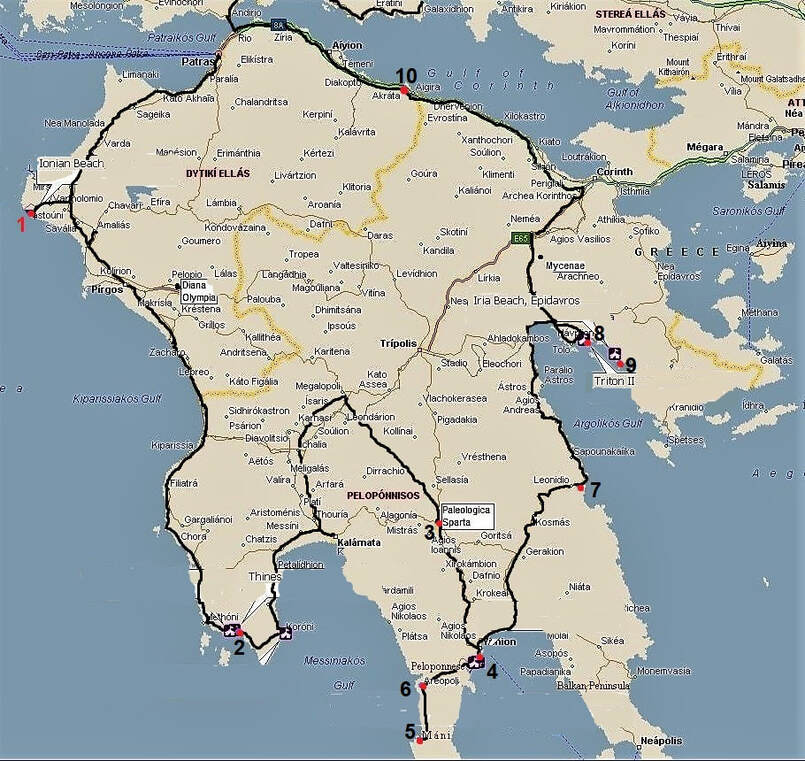
Map of our Motorhome Journey around the Greek Peloponnese
The Ten Places where we stayed in our 60-day tour of the Peloponnese, 614 miles (982 km) by Motorhome and 780 miles (1,250 km) by Bicycle
The Ten Places where we stayed in our 60-day tour of the Peloponnese, 614 miles (982 km) by Motorhome and 780 miles (1,250 km) by Bicycle
- Ionion Beach Camping, Glyfa, Ilia
- Thines Camping, Finikounda, Messinia
- Paleologio Camping, Mystras, Sparta, Lakonia
- Gythion Bay Camping, Gythion, Lakonia
- Gerolimenas Harbour Car Park, Mani Peninsula, Lakonia
- Areopoli Bus Station Car Park, Mani Peninsula, Lakonia
- Semeli Camping, Plaka, Leonidio, Arcadia
- Triton II Camping, Drepano, Nafplio, Argolis
- Iria Beach Camping, Iria, Argolis
- Akrata Beach Camping, Akrata, Achaia
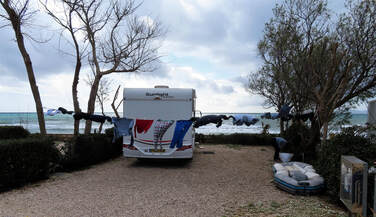
Days Nine to Twenty-six
At Camping Ionion Beach, Glyfa, Ilia, Greek Peloponnese
Click: A Kaleidoscope of Images In and Around Camping Ionion Beach
Settled onto a large sea-front pitch with a view of Zakynthos and very few neighbours (all German-speaking), we enjoyed a week (or three!) at the site which used to be our long-term winter haven in happier pre-Brexit times. Cormorants are still drying their wings on the breakwater by day; Scops Owls sound at dusk. As the weather turned warmer and spring arrived, friends wrote of snow and traffic chaos back in England. Our laundry was line-dried in a couple of hours and the occasional wet day gave time to read and write, using the site’s free WiFi, or to watch old films on local TV, adding to our Greek vocabulary from the subtitles. Above all this is a good base for regaining fitness after a sedentary British winter: cycling the surrounding hills while visiting local ancient sites and modern cafes, as well as walking the long beach in each direction, to Glyfa harbour or Camping Aginara (a campsite that cannot compare!)
At Camping Ionion Beach, Glyfa, Ilia, Greek Peloponnese
Click: A Kaleidoscope of Images In and Around Camping Ionion Beach
Settled onto a large sea-front pitch with a view of Zakynthos and very few neighbours (all German-speaking), we enjoyed a week (or three!) at the site which used to be our long-term winter haven in happier pre-Brexit times. Cormorants are still drying their wings on the breakwater by day; Scops Owls sound at dusk. As the weather turned warmer and spring arrived, friends wrote of snow and traffic chaos back in England. Our laundry was line-dried in a couple of hours and the occasional wet day gave time to read and write, using the site’s free WiFi, or to watch old films on local TV, adding to our Greek vocabulary from the subtitles. Above all this is a good base for regaining fitness after a sedentary British winter: cycling the surrounding hills while visiting local ancient sites and modern cafes, as well as walking the long beach in each direction, to Glyfa harbour or Camping Aginara (a campsite that cannot compare!)
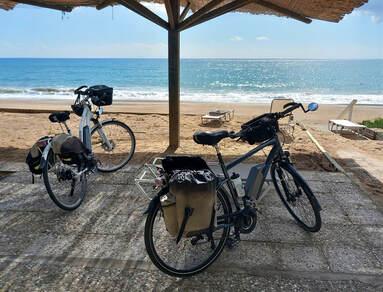
Cycling
On our trusty Volt bikes we covered a total of 353 km (220 miles) in 8 rides - average 44 km, longest 66 km – all on quiet lanes with an occasional dirt track. Apart from the short excursion to Arcoudi and Loutra Killinis, any ride out of Glyfa begins with a 100-metre climb from sea level up to the water tower at Lygia, usually followed by a swift descent to the nearest town of Vartholomio (10 km). Our favourite coffee break was at the corner café by the hotel there, where chocolate-topped cappuccinos are served with a smile and a shortbread biscuit. The small town is also good for shopping, with an ATM, a bakery, Market Inn supermarket and an amazingly good ironmonger’s that replaced a missing Allen Key for Barry’s tool kit, price 2 Euros!
Riding on from Vartholomio took us through dunes to the deserted seashore at Thinon Forest, or to Bouka Beach near the tiny village of Paleohora, or down to the larger town of Gastouni, across the New National Road and beyond to Ancient Elis. Not however along the New Nat Rd, since the hard shoulder has vanished under the new 3-lane system, dangerously squeezing cyclists or pedestrians. To be fair, Greeks neither cycle nor walk willingly.
Alternatively, from Lygia or Loutra Killinis there is a choice of two routes climbing steeply to Kastro, dominated by its castle up at 200 metres, then a descent to inland villages or to the port of Killinis.
On our trusty Volt bikes we covered a total of 353 km (220 miles) in 8 rides - average 44 km, longest 66 km – all on quiet lanes with an occasional dirt track. Apart from the short excursion to Arcoudi and Loutra Killinis, any ride out of Glyfa begins with a 100-metre climb from sea level up to the water tower at Lygia, usually followed by a swift descent to the nearest town of Vartholomio (10 km). Our favourite coffee break was at the corner café by the hotel there, where chocolate-topped cappuccinos are served with a smile and a shortbread biscuit. The small town is also good for shopping, with an ATM, a bakery, Market Inn supermarket and an amazingly good ironmonger’s that replaced a missing Allen Key for Barry’s tool kit, price 2 Euros!
Riding on from Vartholomio took us through dunes to the deserted seashore at Thinon Forest, or to Bouka Beach near the tiny village of Paleohora, or down to the larger town of Gastouni, across the New National Road and beyond to Ancient Elis. Not however along the New Nat Rd, since the hard shoulder has vanished under the new 3-lane system, dangerously squeezing cyclists or pedestrians. To be fair, Greeks neither cycle nor walk willingly.
Alternatively, from Lygia or Loutra Killinis there is a choice of two routes climbing steeply to Kastro, dominated by its castle up at 200 metres, then a descent to inland villages or to the port of Killinis.
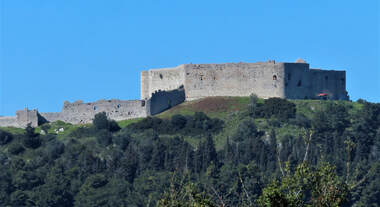
Ancient Sites
Our cycle rides took us to a range of ancient sites in the area, reflecting Greece’s long history - and all within 32 km/20 miles of Glyfa:
It's an easy 7-km ride via Arcoudi to the remains of Roman baths at Loutra Killinis (Lintzi), where the sulphurous thermal water still serves a modern spa complex.
An 11-km ride up to the village of Kastro and its medieval Frankish Castle of Chlemoutsi is well worth the effort for the views over the agricultural Plain of Elis and the blue Ionian Sea. The interior of the imposing castle is open to visit daily for a small fee.
From Kastro we rode down through Neohori (with a nice bakery serving coffee, savoury pies and sweet buns) to Andravida. There is little evidence that this humble town was once the Frankish capital of Achaea, apart from the locked ruins of the medieval church of Agia Sophia in the centre. The church of Agia Paraskevi in the nearby village of Strousi was more impressive, if less historic.
Our cycle rides took us to a range of ancient sites in the area, reflecting Greece’s long history - and all within 32 km/20 miles of Glyfa:
It's an easy 7-km ride via Arcoudi to the remains of Roman baths at Loutra Killinis (Lintzi), where the sulphurous thermal water still serves a modern spa complex.
An 11-km ride up to the village of Kastro and its medieval Frankish Castle of Chlemoutsi is well worth the effort for the views over the agricultural Plain of Elis and the blue Ionian Sea. The interior of the imposing castle is open to visit daily for a small fee.
From Kastro we rode down through Neohori (with a nice bakery serving coffee, savoury pies and sweet buns) to Andravida. There is little evidence that this humble town was once the Frankish capital of Achaea, apart from the locked ruins of the medieval church of Agia Sophia in the centre. The church of Agia Paraskevi in the nearby village of Strousi was more impressive, if less historic.
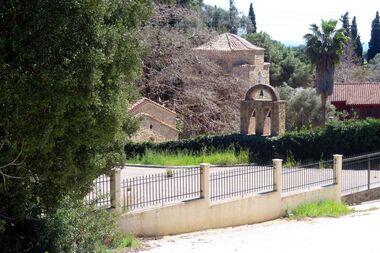
Our longest ride at 64 km was to the archaeological site of Ancient Elis and the extensive Greco-Roman remains of the City State which once held authority over the Olympic Games at Olympia. Entry to the site and the little old museum is free, though most of the finds are now housed in a white elephant of a new museum tucked away in the village of Ilida on the other side of the acropolis hill. The new museum has a small entry fee for those who can find it but the best experience is to ramble among the ruins of the theatre, temples and dwellings that spread alongside the Pineos River.
The Monastery of Panagia Eleousa is only 4 km from the campsite, yet in another world! Ride 2 km uphill, almost to Lygia, then take a signed right turn leading 2 km very steeply down to a little convent at the end of the paved track. Years ago we found this Moni inhabited by friendly nuns who gave us food and couldn’t understand why we spoke in strange tongues! But today the church and cells are deserted and locked, though visitors are welcome on the afternoons of Tues, Wed and Thursday. The monastery was originally erected in the 9th century, following the discovery of an icon of the Virgin Mary in a nearby cave (a familiar story in Greece!) In 1683, after being pillaged by pirates, it was renovated and a high stone wall built around it including a high observation tower. It proved a good test for the electric bikes to regain the road to Lygia!
Our last ride from Glyfa was a descent from Kastro to the scant ruins of the medieval port of Glarentza (19 km), just beyond the modern harbour of Killinis from where regular Levante ferries cross to Zakynthos or Kefalonia.
The Monastery of Panagia Eleousa is only 4 km from the campsite, yet in another world! Ride 2 km uphill, almost to Lygia, then take a signed right turn leading 2 km very steeply down to a little convent at the end of the paved track. Years ago we found this Moni inhabited by friendly nuns who gave us food and couldn’t understand why we spoke in strange tongues! But today the church and cells are deserted and locked, though visitors are welcome on the afternoons of Tues, Wed and Thursday. The monastery was originally erected in the 9th century, following the discovery of an icon of the Virgin Mary in a nearby cave (a familiar story in Greece!) In 1683, after being pillaged by pirates, it was renovated and a high stone wall built around it including a high observation tower. It proved a good test for the electric bikes to regain the road to Lygia!
Our last ride from Glyfa was a descent from Kastro to the scant ruins of the medieval port of Glarentza (19 km), just beyond the modern harbour of Killinis from where regular Levante ferries cross to Zakynthos or Kefalonia.
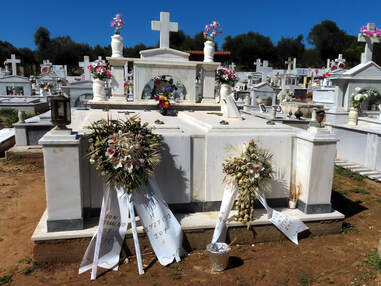
Greek Orthodox Memorial Service
We felt very privileged to be invited to join a small graveside service at the Fligos family church of Agia Marina in Glyfa, where Michael had been buried in the family tomb alongside his mother and father (the latter living to age 104). In accordance with the Orthodox rites (which do not allow cremation), Michael’s coffin had been taken straight to the church, to be interred on the day following his death. On the ninth day, the memorial ritual that we attended, the family and close friends gathered in the graveyard to celebrate his life. Fresh flowers were placed on the tomb and candles (bought inside the church) were lit and placed alongside the two wreaths (a heart-shaped one from his widow and a cross-shaped one from the sons and grandchildren). The priest read a short service, in which everyone (except us) knew when to cross themselves.
We felt very privileged to be invited to join a small graveside service at the Fligos family church of Agia Marina in Glyfa, where Michael had been buried in the family tomb alongside his mother and father (the latter living to age 104). In accordance with the Orthodox rites (which do not allow cremation), Michael’s coffin had been taken straight to the church, to be interred on the day following his death. On the ninth day, the memorial ritual that we attended, the family and close friends gathered in the graveyard to celebrate his life. Fresh flowers were placed on the tomb and candles (bought inside the church) were lit and placed alongside the two wreaths (a heart-shaped one from his widow and a cross-shaped one from the sons and grandchildren). The priest read a short service, in which everyone (except us) knew when to cross themselves.
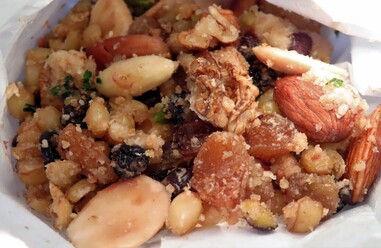
Finally, the traditional memorial food was handed out: a special sweet bun and a small bag of Kollyva for each person, both delicious. Kollyva is a mixture of nuts, dried fruit, seeds, boiled wheat and honey that is used liturgically in the Eastern Orthodox Church for commemorations of the dead. We hope it wasn’t disrespectful to incorporate it into a chocolate cake that I made in Michael’s memory.
George Fligos told us that, in accordance with custom, the formal church funeral service will be held on the 40th day. This lasts about 2 hours and is followed by coffee and a substantial meal, already booked for 200 people (including the church congregation) in a hotel.
George Fligos told us that, in accordance with custom, the formal church funeral service will be held on the 40th day. This lasts about 2 hours and is followed by coffee and a substantial meal, already booked for 200 people (including the church congregation) in a hotel.
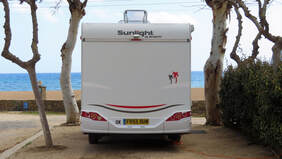
Day Twenty-seven 120 miles
Glyfa to Camping Thines, Finikounda, Greek Peloponnese
After the Vernal Equinox, spring heralded settled weather and burgeoning flowers. Time to move on. Driving south from Gastouni on the New National Road, we had five breaks at favourite spots along the way. Traffic was fairly quiet, with a marked absence of leisure vehicles.
First stop was a detour towards Amaliada to restock at the excellent new Lidl store before continuing to Pyrgos, where the 3-lane system ended as the road narrowed. Then a short diversion for a lunch break by the sulphurous Lake Kaiafas before Zacharo. On through Kiparissia and Filiatra to take the coastal road, with a third break on the little harbour at Agia Kyriaki where workers were readying the taverna for Easter with plenty of blue and white paint. A few miles further in Marathopoli we turned inland towards Gargaliani to join the finished section of a new bypass towards Pylos, which will one day begin in Filiatra. The smooth highway ended at Romanos, depositing us on the old road past the extensive ‘Navarino Dunes’ resort and eventually down into Pylos. Here we parked on the harbour alongside Navarino Bay for a walk, an ice cream and to get a watch battery fitted at the only jeweller’s we know in the area. Our last stop was in Methoni, the small town where we were married, to walk along the sea front to check out the campsite, which was closed. ‘Maybe open in two weeks …’
So we continued another 7 miles down the coast to a very familiar base and cycling centre in the small fishing harbour/summer resort of Finikounda. There are no less than five campsites here, though only one now stays open all year: Camping Thines (meaning Dunes), run by two generations of the Tomaras family. We took the last vacant sea-view pitch and settled in.
Glyfa to Camping Thines, Finikounda, Greek Peloponnese
After the Vernal Equinox, spring heralded settled weather and burgeoning flowers. Time to move on. Driving south from Gastouni on the New National Road, we had five breaks at favourite spots along the way. Traffic was fairly quiet, with a marked absence of leisure vehicles.
First stop was a detour towards Amaliada to restock at the excellent new Lidl store before continuing to Pyrgos, where the 3-lane system ended as the road narrowed. Then a short diversion for a lunch break by the sulphurous Lake Kaiafas before Zacharo. On through Kiparissia and Filiatra to take the coastal road, with a third break on the little harbour at Agia Kyriaki where workers were readying the taverna for Easter with plenty of blue and white paint. A few miles further in Marathopoli we turned inland towards Gargaliani to join the finished section of a new bypass towards Pylos, which will one day begin in Filiatra. The smooth highway ended at Romanos, depositing us on the old road past the extensive ‘Navarino Dunes’ resort and eventually down into Pylos. Here we parked on the harbour alongside Navarino Bay for a walk, an ice cream and to get a watch battery fitted at the only jeweller’s we know in the area. Our last stop was in Methoni, the small town where we were married, to walk along the sea front to check out the campsite, which was closed. ‘Maybe open in two weeks …’
So we continued another 7 miles down the coast to a very familiar base and cycling centre in the small fishing harbour/summer resort of Finikounda. There are no less than five campsites here, though only one now stays open all year: Camping Thines (meaning Dunes), run by two generations of the Tomaras family. We took the last vacant sea-view pitch and settled in.
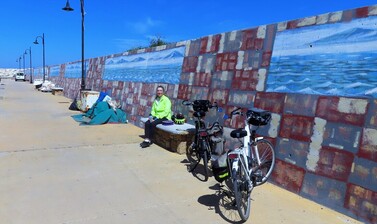
Days Twenty-eight to Forty-six
At Camping Thines, Finikounda, Messinia, Greek Peloponnese
At the campsite we used the laundry, cursed the hit-and-miss Wifi and sampled Despina’s cooking (Friday evenings only). But we were here, as ever, to ride our bikes.
Cycling
For us, Finikounda is simply the Cycling Capital of Greece, with the unique attraction of its network of cycle routes on quiet lanes, opening up a different world to be experienced at close quarters.
Even the short ride to Methoni with its magnificent Venetian castle (10 km west along the main road) can be varied by climbing the old road via Fini, or Kamaria and Evangelismos. The larger port of Pilos was reached by riding via Pidassos and Mesohori rather than along the narrow busy route directly from Methoni. On Greek Independence Day (25 March, celebrating the start of the war against the Turks in 1821) the flags were out as we rode the main road east to Koroni and another splendid castle (now a convent) overlooking the harbour, returning via Harokopio and the villages of Iamia and Akritohori.
At Camping Thines, Finikounda, Messinia, Greek Peloponnese
At the campsite we used the laundry, cursed the hit-and-miss Wifi and sampled Despina’s cooking (Friday evenings only). But we were here, as ever, to ride our bikes.
Cycling
For us, Finikounda is simply the Cycling Capital of Greece, with the unique attraction of its network of cycle routes on quiet lanes, opening up a different world to be experienced at close quarters.
Even the short ride to Methoni with its magnificent Venetian castle (10 km west along the main road) can be varied by climbing the old road via Fini, or Kamaria and Evangelismos. The larger port of Pilos was reached by riding via Pidassos and Mesohori rather than along the narrow busy route directly from Methoni. On Greek Independence Day (25 March, celebrating the start of the war against the Turks in 1821) the flags were out as we rode the main road east to Koroni and another splendid castle (now a convent) overlooking the harbour, returning via Harokopio and the villages of Iamia and Akritohori.
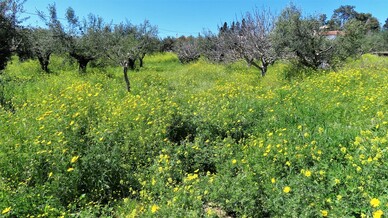
The best rides linked the inland hill villages, where old ladies dressed in black gather wild greens, men work in the fields or at the olives and an occasional donkey still trots home, its panniers laden with firewood. The spring weather was perfect with a riot of flowers in the meadows, orchards and roadside verges, attracting butterflies. Over ten rides, totalling 342 km, we climbed every hill out of Finikounda through tiny villages like (in no particular order) Perivolakia, Kallithea, Homatada, Kinigou, Grizokampos, Kaplani, Militsa, Zizani, Exochiko, Lachanada, Falanthi, Homatera, Chrisokellaria: many with a friendly Kafenion for coffee. Names redolent with memories and all unknown to the sun-seekers down at the coast.
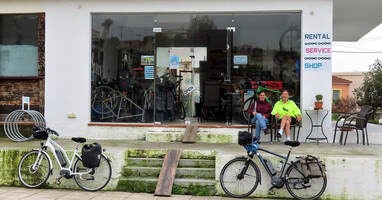
Finibikes
A special thanks once again to our friends Nikos and Julie at Finibikes, their wonderful emporium in Finikounda offering sales, rental, repairs – and a constant supply of advice, coffee, snacks and meaningful conversation. This time, Nikos fixed my rear brake disk (slightly damaged by a stone on a swift descent from Kaplani) and replaced worn brake pads on both our e-bikes. He also treated us to a trial run on two new electric gravel bikes, though we weren’t tempted by the fatter tyres. His present of four fresh ‘Geeseggs’ (his friend keeps geese!) was much appreciated, resulting in a monster omelette and some enriched baking. Another gift, of crystallised Hibiscus flowers, will decorate my next cake.
A special thanks once again to our friends Nikos and Julie at Finibikes, their wonderful emporium in Finikounda offering sales, rental, repairs – and a constant supply of advice, coffee, snacks and meaningful conversation. This time, Nikos fixed my rear brake disk (slightly damaged by a stone on a swift descent from Kaplani) and replaced worn brake pads on both our e-bikes. He also treated us to a trial run on two new electric gravel bikes, though we weren’t tempted by the fatter tyres. His present of four fresh ‘Geeseggs’ (his friend keeps geese!) was much appreciated, resulting in a monster omelette and some enriched baking. Another gift, of crystallised Hibiscus flowers, will decorate my next cake.
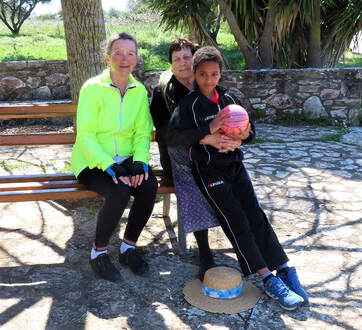
Old Friends Past and Present in Mistraki
On a sunny Sunday, as summertime dawned, we rode up through Kaplani to the near-abandoned ‘traditional village’ of Mistraki, the former home of our good friends John and Lisi, now living in Ireland. We miss their presence but did find an old Greek friend, dear Fortini. She was sitting in the shade of a tree opposite her cottage, watching her nine-year-old grandson Nikos (named after her late husband) at play. The lad knew enough school English to explain that his mother, Helen, was at work in the fields while his father was asleep inside. Some things never change!
On a sunny Sunday, as summertime dawned, we rode up through Kaplani to the near-abandoned ‘traditional village’ of Mistraki, the former home of our good friends John and Lisi, now living in Ireland. We miss their presence but did find an old Greek friend, dear Fortini. She was sitting in the shade of a tree opposite her cottage, watching her nine-year-old grandson Nikos (named after her late husband) at play. The lad knew enough school English to explain that his mother, Helen, was at work in the fields while his father was asleep inside. Some things never change!
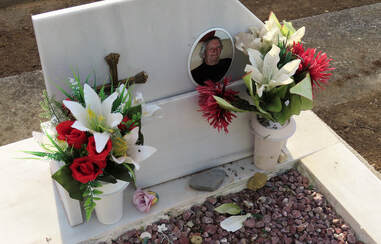
Rod’s Grave
We also paid our respects to another old friend, Rod, now at peace in Finikounda graveyard. We learnt of his death last year when we called in at Camping Finikes, where he was for many years the winter guardian. That campsite is now closed in the low season, as the owner lives in Pylos. At the graveyard we met Despina (matriarch of Camping Thines) tending her mother-in-law’s grave. She would know every family in the lovingly kept church yard, with the same surnames repeated, recalling the close community of a fishing village.
We also paid our respects to another old friend, Rod, now at peace in Finikounda graveyard. We learnt of his death last year when we called in at Camping Finikes, where he was for many years the winter guardian. That campsite is now closed in the low season, as the owner lives in Pylos. At the graveyard we met Despina (matriarch of Camping Thines) tending her mother-in-law’s grave. She would know every family in the lovingly kept church yard, with the same surnames repeated, recalling the close community of a fishing village.
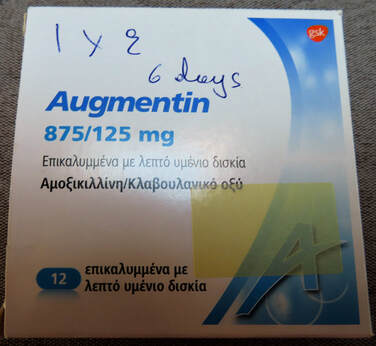
A Thorny Issue
After a few days in Finikounda, ready to move on, we were overtaken by events when Barry tripped on a short walk back from the village. He fell onto a pile of palm tree prunings, one of which spiked his leg and made a puncture wound (through trousers!), which we simply stuck a plaster on. Next day the leg was painful and the village pharmacist, Anastasia, directed us to the doctor, a pleasant young man sitting in a tiny unmarked surgery across the lane. He wrote a prescription for Augmentin antibiotics and an anti-tetanus vaccine, which we then collected from said pharmacy and returned to the doctor to administer the jab. He also advised that Barry should avoid eating fish or dairy and take yogurt at bedtime (because it’s Orthodox Lent, we wondered?) ‘Come back in a week if no better’ he added.
After a few days in Finikounda, ready to move on, we were overtaken by events when Barry tripped on a short walk back from the village. He fell onto a pile of palm tree prunings, one of which spiked his leg and made a puncture wound (through trousers!), which we simply stuck a plaster on. Next day the leg was painful and the village pharmacist, Anastasia, directed us to the doctor, a pleasant young man sitting in a tiny unmarked surgery across the lane. He wrote a prescription for Augmentin antibiotics and an anti-tetanus vaccine, which we then collected from said pharmacy and returned to the doctor to administer the jab. He also advised that Barry should avoid eating fish or dairy and take yogurt at bedtime (because it’s Orthodox Lent, we wondered?) ‘Come back in a week if no better’ he added.
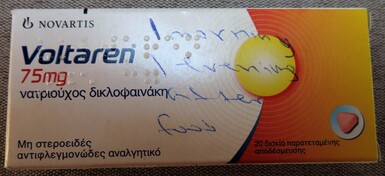
It wasn’t, so we did. The doctor injected an anaesthetic, poked about the wound, sprayed it with Pulvo antiseptic powder and prescribed another week of antibiotics. He was very kind and refused payment but we didn’t like the mention of Kalamata hospital and surgery if it didn’t improve! With Barry’s sore leg and foot remaining swollen, we arranged delivery of a hire car for a week (15 Euros a day from the ever-reliable AutoUnion Rentals in Pylos) to enable a second opinion and further treatment elsewhere. Starting in Pylos, we were directed to the charming old Dr Dougas, a private doctor who seemed very experienced. He prescribed anti-inflammatory Voltaren tablets and a Pulvo spray, in addition to finishing the second round of antibiotics, and we were to return in 3 days.

Meanwhile, we made good use of the car with a run to Messini and the well-stocked Lidl. After the final visit to Dr Dougas, Barry was reassured that there was no infection and the swelling would go down, which it eventually did. Apart from prescription charges, there were no costs involved, though Dr Dougas accepted 20 Euros when we insisted! Perhaps EHIC paperwork would be too much trouble in Greece. And we walked straight into both the surgeries, with no appointment, phone call or queue, just as I have in the past when using a Greek dentist. So much for our wonderful NHS system.
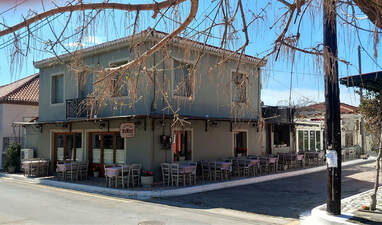
A Happy Birthday
My birthday fell on Easter Monday (the ‘Catholic’ one, a week before Orthodox Easter this year), whilst we still had the hire car. This enabled a picnic at the Voidokilia Lagoon near Gialova, where the overwintering flamingos had sadly gone, though we did see Great White Egrets at the water. We ended the celebration with a meal at the excellent Nicos Taverna in Methoni, followed by a night and a splendid breakfast at the Achilles Hotel there. I had already made a lemon gateau (involving home-made lemon curd and one ‘geesegg’ = 2.5 hen eggs) for the occasion, which was enjoyed for several days!
My birthday fell on Easter Monday (the ‘Catholic’ one, a week before Orthodox Easter this year), whilst we still had the hire car. This enabled a picnic at the Voidokilia Lagoon near Gialova, where the overwintering flamingos had sadly gone, though we did see Great White Egrets at the water. We ended the celebration with a meal at the excellent Nicos Taverna in Methoni, followed by a night and a splendid breakfast at the Achilles Hotel there. I had already made a lemon gateau (involving home-made lemon curd and one ‘geesegg’ = 2.5 hen eggs) for the occasion, which was enjoyed for several days!
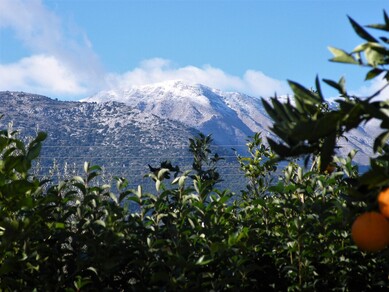
Big Week of Films
The Holy Week leading up to Greek Orthodox Easter Sunday (16 April this year), known as Big Week (Megali Evdomada) is marked by the films shown each evening on Greek TV channels. Every known English/American biblical film or Roman epic appears, with Greek subtitles: the Jesus of Nazareth series competed with biopics of Goliath, Noah or Moses, as well as Ben Hur (old and new versions), Spartacus, etc etc. Nikos at Finibikes told us that at school they were taught the Orthodox religion, and told that there was also a Catholic religion and ‘some other beliefs’. Even Protestants were beyond the pale!
Day Fortyseven 98 miles driven
To Camping Paleologio, Mystras, Sparta, Lakonia, Greek Peloponnese
On ‘Big Wednesday’ we left the hire car to be collected from Camping Thines and bade farewell to Finibikes, leaving Finikounda after an unanticipated three weeks. The motorhome carried us to Messini to restock at Lidl, with a lunch of sausage rolls, spinach pies and croissants from their generous bakery. Then we took the A7 motorway (signed Sparti and Athens), rising inland to 550 m before joining A71 for Sparti, still climbing. The detour on the new motorways cost 15.30 Euros in tolls but is a much easier route, avoiding Kalamata and the Langada Pass which we know of old.
From exit 17E (signed Sparti and Mystras) it was just 3 miles through the city centre and along the Mystras road to Camping Paleologio, an ancient site in itself! Peter (son of the camping’s late founder) was smiling in Reception to greet us once again. We settled in under the sunny citrus trees with a superb view of the Taigetos mountains, still flecked with snow in the high gulleys. The site was almost empty (due to the high price and the appalling facilities) but we had come for the sole purpose of two challenging cycle rides. Yes, Barry was feeling much better now he had finished taking the tablets and his Big Foot was returning to normal.
The Holy Week leading up to Greek Orthodox Easter Sunday (16 April this year), known as Big Week (Megali Evdomada) is marked by the films shown each evening on Greek TV channels. Every known English/American biblical film or Roman epic appears, with Greek subtitles: the Jesus of Nazareth series competed with biopics of Goliath, Noah or Moses, as well as Ben Hur (old and new versions), Spartacus, etc etc. Nikos at Finibikes told us that at school they were taught the Orthodox religion, and told that there was also a Catholic religion and ‘some other beliefs’. Even Protestants were beyond the pale!
Day Fortyseven 98 miles driven
To Camping Paleologio, Mystras, Sparta, Lakonia, Greek Peloponnese
On ‘Big Wednesday’ we left the hire car to be collected from Camping Thines and bade farewell to Finibikes, leaving Finikounda after an unanticipated three weeks. The motorhome carried us to Messini to restock at Lidl, with a lunch of sausage rolls, spinach pies and croissants from their generous bakery. Then we took the A7 motorway (signed Sparti and Athens), rising inland to 550 m before joining A71 for Sparti, still climbing. The detour on the new motorways cost 15.30 Euros in tolls but is a much easier route, avoiding Kalamata and the Langada Pass which we know of old.
From exit 17E (signed Sparti and Mystras) it was just 3 miles through the city centre and along the Mystras road to Camping Paleologio, an ancient site in itself! Peter (son of the camping’s late founder) was smiling in Reception to greet us once again. We settled in under the sunny citrus trees with a superb view of the Taigetos mountains, still flecked with snow in the high gulleys. The site was almost empty (due to the high price and the appalling facilities) but we had come for the sole purpose of two challenging cycle rides. Yes, Barry was feeling much better now he had finished taking the tablets and his Big Foot was returning to normal.
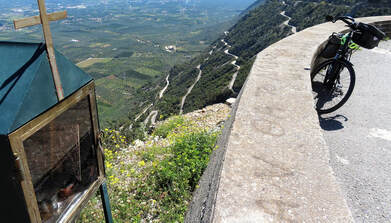
Days Forty-eight to Forty-nine
At Camping Paleologio, Mystras, Sparta, Lakonia, Greek Peloponnese
Cycling
We began by riding the virtually empty road up to the village of Anavriti, which lies on the E4 hiking route to the snowy summit of Mount Taigetos. Our 16-km ascent, with about a dozen hairpin bends, ended happily at the friendly central taverna at 800 m or 2,800 ft – a climb of 2,000 ft from the campsite. After coffee and copious spring water, gushing from the fountain by which we sat, we freewheeled back, zigzagging down to the plain of Sparta. As I paused to scrump a few large oranges left overhanging the road, Barry spotted the first tortoise of the season, ambling along the verge munching flowers. Ice creams in the centre of Mystras were our treat.
At Camping Paleologio, Mystras, Sparta, Lakonia, Greek Peloponnese
Cycling
We began by riding the virtually empty road up to the village of Anavriti, which lies on the E4 hiking route to the snowy summit of Mount Taigetos. Our 16-km ascent, with about a dozen hairpin bends, ended happily at the friendly central taverna at 800 m or 2,800 ft – a climb of 2,000 ft from the campsite. After coffee and copious spring water, gushing from the fountain by which we sat, we freewheeled back, zigzagging down to the plain of Sparta. As I paused to scrump a few large oranges left overhanging the road, Barry spotted the first tortoise of the season, ambling along the verge munching flowers. Ice creams in the centre of Mystras were our treat.
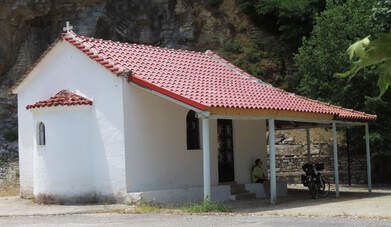
Our second ride to Georgitsi was longer and harder, at 59 km return. From Magoula we took the hillier route via Soustiani (with a coffee stop), Soulina and the larger village of Kastoria, where the pavements were filled with folk eating and drinking, this being the Good Friday (Megali Paraskevi) holiday. The last few miles hairpinned up to Georgitsi at 900 m or 3,000 ft, where we rested in the park with our sandwiches before descending swiftly through and past Kastoria. When the road forked, we spared the bike batteries by taking the alternative route directly to Sparta: the same distance but less climbing than the outward route through the villages.
The evening news on TV covered the mournful church services and processions of the Epitaphios, representing Christ’s coffin, carried round towns and villages, richly decorated with fresh flowers. We watched the parade from Athens Cathedral to Syntagma Square, from St Andrew’s Cathedral around Patras, and another in Corinth. The faithful carried candles and looked suitably solemn.
The evening news on TV covered the mournful church services and processions of the Epitaphios, representing Christ’s coffin, carried round towns and villages, richly decorated with fresh flowers. We watched the parade from Athens Cathedral to Syntagma Square, from St Andrew’s Cathedral around Patras, and another in Corinth. The faithful carried candles and looked suitably solemn.
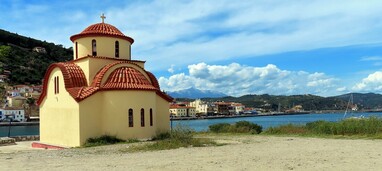
Day Fifty 31 miles driven
To Camping Gythion Bay, Gythio, Lakonia, Greek Peloponnese
On Orthodox Easter Saturday, pausing only to shop at Sparta’s busy Lidl, we drove the short distance to the coast at Gythion, a fishing port at which we once arrived by ferry from Crete. There are three campsites strung along the beach a couple of miles southwest of the town and we chose the middle one, which boasts a shop, restaurant, bar and swimming pool (all closed, as were two of the four sanitary blocks, even though the site had re-opened on 1st April ready for Easter!) The site WiFi only worked around the windy pool area, where there are no pitches and the grass is made of plastic! Unimpressed, we parked among the olive trees and planned our next move.
To Camping Gythion Bay, Gythio, Lakonia, Greek Peloponnese
On Orthodox Easter Saturday, pausing only to shop at Sparta’s busy Lidl, we drove the short distance to the coast at Gythion, a fishing port at which we once arrived by ferry from Crete. There are three campsites strung along the beach a couple of miles southwest of the town and we chose the middle one, which boasts a shop, restaurant, bar and swimming pool (all closed, as were two of the four sanitary blocks, even though the site had re-opened on 1st April ready for Easter!) The site WiFi only worked around the windy pool area, where there are no pitches and the grass is made of plastic! Unimpressed, we parked among the olive trees and planned our next move.
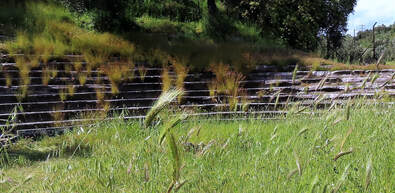
Day Fifty-one
At Camping Gythion Bay, Gythio, Lakonia, Greek Peloponnese
Orthodox Easter Day with a campsite chorus of Christos Anesti (Christ is Risen) and ‘Why isn’t the restaurant open?’ Answer: ‘We can’t get any staff to work today!’
Marmalade and Chips
The oranges from Sparta proved as sweet as the scent of orange blossom, ideal for squeezing for juice. I also made three jars of marmalade – and a new friend – in the campsite kitchen (one good feature, with gas rings and fridges). Working alongside Georgia from Athens, who was frying mounds of chips for the family barbecue, I was told to eat as many as I liked (and didn’t need too much encouragement)! This exhortation came with the gift of a hard-boiled red-painted egg and later with plates of pork souvlaki and salad that we ate for lunch. A lovely woman, looking forward to retirement next year when they can make more use of their Hymer motorhome.
A Short Ride
In the afternoon we cycled into Gythion (5 km), up a slight hill, then down a separate bike path (unusual in Greece) to the port. We rode by the Greek Navy Lighthouse (Keep Out) and Mani Museum (closed), then along the quiet waterfront to a bar on the main street for coffee. Very few places were open. On the far side of the town we found the vestiges of the Ancient Theatre, sadly overgrown, next to the army barracks (keep out, no photos). Returning to the campsite, the ride totalled 15 km.
At Camping Gythion Bay, Gythio, Lakonia, Greek Peloponnese
Orthodox Easter Day with a campsite chorus of Christos Anesti (Christ is Risen) and ‘Why isn’t the restaurant open?’ Answer: ‘We can’t get any staff to work today!’
Marmalade and Chips
The oranges from Sparta proved as sweet as the scent of orange blossom, ideal for squeezing for juice. I also made three jars of marmalade – and a new friend – in the campsite kitchen (one good feature, with gas rings and fridges). Working alongside Georgia from Athens, who was frying mounds of chips for the family barbecue, I was told to eat as many as I liked (and didn’t need too much encouragement)! This exhortation came with the gift of a hard-boiled red-painted egg and later with plates of pork souvlaki and salad that we ate for lunch. A lovely woman, looking forward to retirement next year when they can make more use of their Hymer motorhome.
A Short Ride
In the afternoon we cycled into Gythion (5 km), up a slight hill, then down a separate bike path (unusual in Greece) to the port. We rode by the Greek Navy Lighthouse (Keep Out) and Mani Museum (closed), then along the quiet waterfront to a bar on the main street for coffee. Very few places were open. On the far side of the town we found the vestiges of the Ancient Theatre, sadly overgrown, next to the army barracks (keep out, no photos). Returning to the campsite, the ride totalled 15 km.
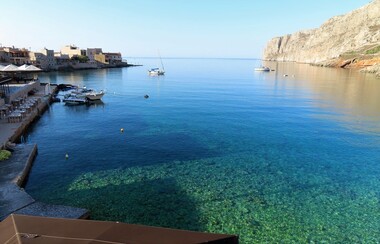
Day Fifty-two 28 miles driven
To Gerolimenas Harbour Car Park, Mani Peninsula, Lakonia, Greek Peloponnese
We drove the short distance to Areopoli, then down the west coast of the Mani Peninsula to Gerolimenas. This being a public holiday (Easter Monday), with an astonishing number of day-trippers parked in and around both Areopoli and Gerolimenas, we were lucky to find space to stop up a lane behind the official car park. There were cars, coaches and a few campervans (German, Austrian and Swedish), quite a surprise after several previous visits to this sleepy little fishing harbour by car, bicycle and motorhome! We strolled round the picturesque waterfront and moved the motorhome onto the car park once the visitors began to leave.
To Gerolimenas Harbour Car Park, Mani Peninsula, Lakonia, Greek Peloponnese
We drove the short distance to Areopoli, then down the west coast of the Mani Peninsula to Gerolimenas. This being a public holiday (Easter Monday), with an astonishing number of day-trippers parked in and around both Areopoli and Gerolimenas, we were lucky to find space to stop up a lane behind the official car park. There were cars, coaches and a few campervans (German, Austrian and Swedish), quite a surprise after several previous visits to this sleepy little fishing harbour by car, bicycle and motorhome! We strolled round the picturesque waterfront and moved the motorhome onto the car park once the visitors began to leave.
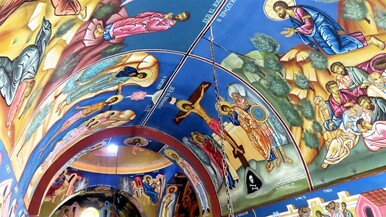
Day Fifty-three 12 miles driven
At Gerolimenas Harbour Car Park/Areopoli Bus Station Car Park, Mani Peninsula, Lakonia, Greek Peloponnese
Cycling a 45-Mile Circuit of the Mani
The longest and toughest ride so far this year, twice rising from sea level to 400 m (so, a total climb of around 3,000 ft). The weather was kind, cooler than last year’s marathon, and dry with a mainly tail wind on the anticlockwise circuit of the rocky peninsula that ends at the southernmost point of the Greek mainland. We began with a hard climb from Alikes, zigzagging up to a break in Lagia and overpriced coffees (M beating the man down from 8 Euros to 7). The priest from Agios Nikolaos, over the road, was also at the taverna and we complimented him on the church’s sumptuous internal restoration, with wooden balcony and colourful frescoes now complete. It was built over 200 years ago by the local feuding clans as an act of reconciliation and peace.
At Gerolimenas Harbour Car Park/Areopoli Bus Station Car Park, Mani Peninsula, Lakonia, Greek Peloponnese
Cycling a 45-Mile Circuit of the Mani
The longest and toughest ride so far this year, twice rising from sea level to 400 m (so, a total climb of around 3,000 ft). The weather was kind, cooler than last year’s marathon, and dry with a mainly tail wind on the anticlockwise circuit of the rocky peninsula that ends at the southernmost point of the Greek mainland. We began with a hard climb from Alikes, zigzagging up to a break in Lagia and overpriced coffees (M beating the man down from 8 Euros to 7). The priest from Agios Nikolaos, over the road, was also at the taverna and we complimented him on the church’s sumptuous internal restoration, with wooden balcony and colourful frescoes now complete. It was built over 200 years ago by the local feuding clans as an act of reconciliation and peace.
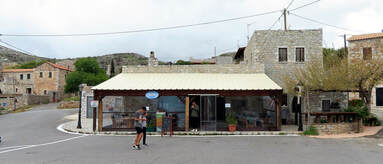
Then it was down to sea level at Kokkala, onward and upward again, and so it went on along the untamed rocky hillsides of the east coast. We were ready for another coffee in Flomohori (a more typical 4 Euros) before crossing the spine of the peninsula, climbing to Chimera and dropping to meet the road down from Areopoli, after 44 km of strenuous riding. In Diros, 8 km south, we took a third break at the wonderful confectioners who charged just 3 Euros for two fruit juices and two chocolate mousses (or mouses). Perhaps the owner felt sorry for us as we sat out on the pavement, pestered by an unhinged old woman screaming at us to buy her honey! The final 20 km to Gerolimenas down the main road was comparatively easy and we reached the motorhome at 5 pm, completing 72 km with 25% to spare on the battery (M) or 17% (B). These numbers do matter!
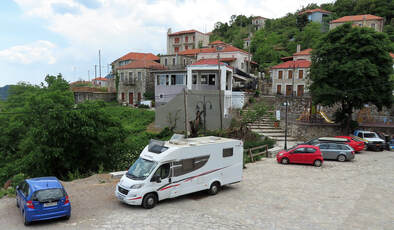
We rewarded ourselves with a ‘Mani Platter for Two’ at the waterside Bekakou Taverna (chicken and pork souvlaki sticks, sausages, pitta bread, tzatziki and salad), all for 20 Euros. And so for another night’s rest on the car park – or so we thought. A gang of local hooligans playing football decided that our motorhome was a good target for the ball, which we duly confiscated when it hit the side of the van. As they began shouting and throwing stones, with no sign of any adults around, we quickly drove off into the night, settling on the bus station car park in Areopolis, alongside a couple of other motorhomes. This should be safer, yes?
NO! At around 2.30 am, woken by loud banging noises, we checked outside. No-one was there but our rear number plate had been partly unscrewed and was hanging off. Perhaps the culprits noticed the rear-view camera above and thought it was CCTV. But why us, why a British plate? Maybe a collector? We didn’t get much sleep after that as four drunken youths arrived on motorbikes and made a lot of noise before leaving. It was a memorable night and our worst free-camping experience ever.
Day Fifty-four 75 miles driven
To Camping Semeli, Plaka, Leonidio, Arcadia, Greek Peloponnese
After last night’s shenanigans Barry luckily found the special screw lying on the ground, so our rear numberplate was reaffixed, with glue for good measure. We were more than pleased to leave after an early breakfast, driving through Gythion while it was still quiet and along the coast to Skala, where we couldn’t but stop at Lidl! Then we climbed inland past Geraki to ascend gradually to Kosmas. After lunch at the war memorial parking area, up at 1200 m, we squeezed through the nigh-impossible village behind two German motorhomes, whose drivers ignored the signs and turned the wrong way into the square. We still wonder how they extricated themselves!
NO! At around 2.30 am, woken by loud banging noises, we checked outside. No-one was there but our rear number plate had been partly unscrewed and was hanging off. Perhaps the culprits noticed the rear-view camera above and thought it was CCTV. But why us, why a British plate? Maybe a collector? We didn’t get much sleep after that as four drunken youths arrived on motorbikes and made a lot of noise before leaving. It was a memorable night and our worst free-camping experience ever.
Day Fifty-four 75 miles driven
To Camping Semeli, Plaka, Leonidio, Arcadia, Greek Peloponnese
After last night’s shenanigans Barry luckily found the special screw lying on the ground, so our rear numberplate was reaffixed, with glue for good measure. We were more than pleased to leave after an early breakfast, driving through Gythion while it was still quiet and along the coast to Skala, where we couldn’t but stop at Lidl! Then we climbed inland past Geraki to ascend gradually to Kosmas. After lunch at the war memorial parking area, up at 1200 m, we squeezed through the nigh-impossible village behind two German motorhomes, whose drivers ignored the signs and turned the wrong way into the square. We still wonder how they extricated themselves!
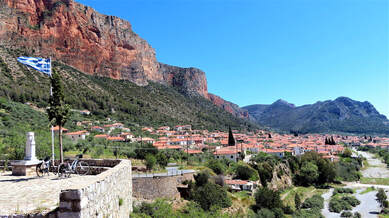
We edged down the hairpins past the Eloni Monastery at 515 m (of which more later) and almost into Leonidio. Following the recommended Caravan route, along the lower road by the dry river and across the third bridge, it was then another couple of miles to the well-signed campsite by the shore. As we arrived another motorhome followed us in. To our surprise the Receptionist asked ‘Are you together?’ – it was another GB (or rather UK), the first we’d seen this year in Greece where German-speakers predominate. In fact this campsite hosts international gatherings, being a favourite base for young rock climbers in tents and campervans. With students still on Easter holidays, it was quite lively and had been full over the weekend.
Settled on a nice level hedged pitch, with reliable WiFi and good facilities, this was a good place to rest and recharge our batteries (literally) before tackling more of our favourite rides.
Settled on a nice level hedged pitch, with reliable WiFi and good facilities, this was a good place to rest and recharge our batteries (literally) before tackling more of our favourite rides.
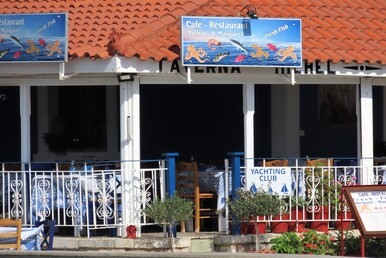
Days Fifty-five to Sixty
At Camping Semeli, Plaka, Leonidio, Arcadia, Greek Peloponnese
The campsite lies between a beach of grey gravel (which doesn’t impress me as a sand-grown’un from Blackpool’s Seven Golden Miles) and a sheer mountainside beckoning to be climbed. It’s only a 4 km ride into the long narrow town of Leonidio, where we found a post office, ATM, hairdresser/barber, good coffee, bakery, ironmongery and other small shops. Or there is a very short walk along the beach or the lane to Plaka harbour, where we had to try ‘Margarets Restaurant’ for a simple dinner in a splendid setting. The local council have even provided a large free car park between campsite and harbour, used by several overnighting motorhomes, though we do feel more comfortable here. Access to electricity, water, showers, toilets, kitchen, laundry and internet has its price but it’s a small one to pay for the added security!
At Camping Semeli, Plaka, Leonidio, Arcadia, Greek Peloponnese
The campsite lies between a beach of grey gravel (which doesn’t impress me as a sand-grown’un from Blackpool’s Seven Golden Miles) and a sheer mountainside beckoning to be climbed. It’s only a 4 km ride into the long narrow town of Leonidio, where we found a post office, ATM, hairdresser/barber, good coffee, bakery, ironmongery and other small shops. Or there is a very short walk along the beach or the lane to Plaka harbour, where we had to try ‘Margarets Restaurant’ for a simple dinner in a splendid setting. The local council have even provided a large free car park between campsite and harbour, used by several overnighting motorhomes, though we do feel more comfortable here. Access to electricity, water, showers, toilets, kitchen, laundry and internet has its price but it’s a small one to pay for the added security!
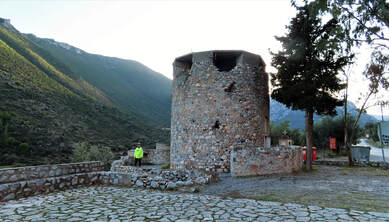
Cycling to the Eloni Monastery
The Eloni Monastery clings to the rockface of Mount Parnon, some 16 km and 650 m above Leonidio and 12 km below Kosmas. The road starts climbing gently out of Leonidio, past the lookout tower and war memorial to those who fell in a Civil War battle on 21 October 1949. Riding up the dry river gorge, with very little traffic, we passed several small wooden signs indicating access to the limestone rock faces named by pioneering climbers of various nationalities: Bella Vista, Grande Cuckoo, Berliner Mauer, Andromeda, Souvlaki (!) We saw a few parked cars and heard voices but couldn’t actually spot any of these intrepid characters. Barry recalled his youth climbing in the Isle of Skye, the Lake District and the gritstone of the Pennines.
The Eloni Monastery clings to the rockface of Mount Parnon, some 16 km and 650 m above Leonidio and 12 km below Kosmas. The road starts climbing gently out of Leonidio, past the lookout tower and war memorial to those who fell in a Civil War battle on 21 October 1949. Riding up the dry river gorge, with very little traffic, we passed several small wooden signs indicating access to the limestone rock faces named by pioneering climbers of various nationalities: Bella Vista, Grande Cuckoo, Berliner Mauer, Andromeda, Souvlaki (!) We saw a few parked cars and heard voices but couldn’t actually spot any of these intrepid characters. Barry recalled his youth climbing in the Isle of Skye, the Lake District and the gritstone of the Pennines.
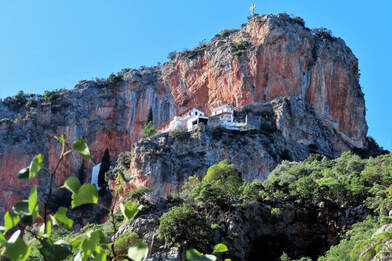
In a small layby just before a bridge, where the road leaves the riverbed and snakes up the mountainside, we paused to eat our pack-up with a superb first view of the monastery clamped to the rocks high above. Then a tail wind helped us round the hairpins up to the entrance and a short steep access road to the monastery gates (open 7 am to 7 pm). There is a small parking area, toilets and stalls selling honey, olives and oil, mountain herbs and scented soap – but nothing to eat or drink. In Greece religious sites do not include a tea-room! The Moni is actually a convent, though any remaining nuns decamp to a more modern building down in Leonidio in the winter, like transhumants. Barry guarded the bikes while I donned trousers (no shorts, please) to investigate. A priest guarded the gift shop offering guidebooks in Greek and religious artifacts; a lone woman was praying to an icon in the small church; a young man handed over a piece of Loukoumi (a Greek tradition, known to us as Turkish Delight!) but no nuns appeared. The view was spectacular.
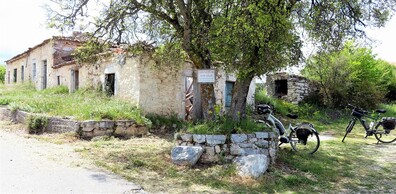
The 16 km descent to Leonidio was mostly a freewheel, with a blustery wind and thankfully no traffic while riding the outside edge of the drop. We enjoyed the 21-km return ride so much that we repeated it three days later!
Cycling past Peleta
There are two routes from the campsite at Plaka to the lofty village of Peleta up at 700 m, south of Leonidio on the seldom-travelled road to Kremasti. Both are about 18 km each way, though our outward route involved an extra 50 m climb over a ridge.
Riding towards Leonidio for 2 km, we turned off left (signed Tsitalia: 9 km) to scale the side of a gorge with breathtaking views back over the town. The road was well graded as it wound relentlessly round hairpins up to Tsitalia, a place with a large church but no discernible café. We climbed out of the village, then dropped slightly to meet the alternative route (from Poulithra) at Pirgoudi: a junction with just one occupied house and one ruined cottage that was For Sale. The sea view was tempting, though the property certainly wasn’t! The road then rolled more gently for 5 km across a high plateau to Peleta, an oasis with three watering holes, a little shop and churches large and small. Over welcome cups of coffee at the first taverna, we watched a mobile greengrocer arrive and wondered how it could be worth his while for just two customers, given the current cost of fuel.
Cycling past Peleta
There are two routes from the campsite at Plaka to the lofty village of Peleta up at 700 m, south of Leonidio on the seldom-travelled road to Kremasti. Both are about 18 km each way, though our outward route involved an extra 50 m climb over a ridge.
Riding towards Leonidio for 2 km, we turned off left (signed Tsitalia: 9 km) to scale the side of a gorge with breathtaking views back over the town. The road was well graded as it wound relentlessly round hairpins up to Tsitalia, a place with a large church but no discernible café. We climbed out of the village, then dropped slightly to meet the alternative route (from Poulithra) at Pirgoudi: a junction with just one occupied house and one ruined cottage that was For Sale. The sea view was tempting, though the property certainly wasn’t! The road then rolled more gently for 5 km across a high plateau to Peleta, an oasis with three watering holes, a little shop and churches large and small. Over welcome cups of coffee at the first taverna, we watched a mobile greengrocer arrive and wondered how it could be worth his while for just two customers, given the current cost of fuel.
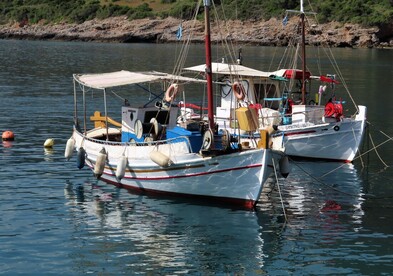
Refreshed, we continued another mile or so to the next hill, then turned back through Peleta. A distressing sight along the way was the remains of two tortoises, whose shells had been no defence as they crossed the road at the wrong moment. A large black crow was picking over the carnage. From Pirgoudi junction we took the right-hand route, zigzagging sharply down the mountainside and through the steep narrow village of Poulithra to its little fishing harbour below, where we watched a small boat go out while our bike brakes cooled. Plaka harbour and our campsite were then a short easy ride north up the coast road. It was a perfect day’s cycling: 30 miles of sunshine, with sea and sky competing for the clearest blue.
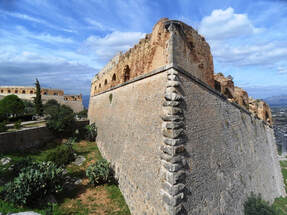
Day Sixty-one 60 miles driven
To Camping Triton II, Drepano, Nafplio, Argolis, Greek Peloponnese
The quiet coast road weaving its way north from Leonidio via Agios Andreas and Astros may not climb very high but there are splendid views of the startlingly blue sea below and the odd campsite, accessible only down impossibly narrow and steep concrete drives. We paused after 35 miles at the northern end of Paralio Astros, with plenty of parking space on waste ground or by a closed seafront restaurant, then rounded Nafplio Bay through Nea Kios.
Nafplio, the first capital of independent Greece, has a large port, a magnificently dominant hilltop castle, rows of double-parked traffic – and a Lidl store. Here we stopped to shop and eat lunch before driving the final 7 miles through the village of Drepano to nearby Plaka Beach. There are a couple of scruffy-looking seasonal campsites but we prefer the last one, open year-round, with peaceful hedged pitches, good facilities and reliable WiFi. Christina, the English-speaking resident owner, remembered us well.
To Camping Triton II, Drepano, Nafplio, Argolis, Greek Peloponnese
The quiet coast road weaving its way north from Leonidio via Agios Andreas and Astros may not climb very high but there are splendid views of the startlingly blue sea below and the odd campsite, accessible only down impossibly narrow and steep concrete drives. We paused after 35 miles at the northern end of Paralio Astros, with plenty of parking space on waste ground or by a closed seafront restaurant, then rounded Nafplio Bay through Nea Kios.
Nafplio, the first capital of independent Greece, has a large port, a magnificently dominant hilltop castle, rows of double-parked traffic – and a Lidl store. Here we stopped to shop and eat lunch before driving the final 7 miles through the village of Drepano to nearby Plaka Beach. There are a couple of scruffy-looking seasonal campsites but we prefer the last one, open year-round, with peaceful hedged pitches, good facilities and reliable WiFi. Christina, the English-speaking resident owner, remembered us well.
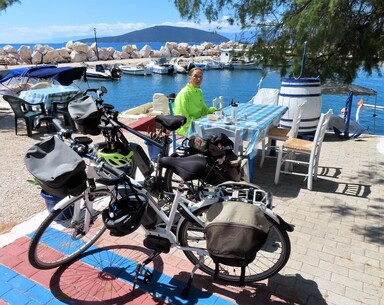
Days Sixty-two to Sixty-four
At Camping Triton II, Drepano, Nafplio, Argolis, Greek Peloponnese.
Cycling to Iria Beach and Tolo
A morning ride through Drepano village, east along the coast to Vivari and over a headland led to Irion Beach, for coffee at the small harbour. Returning we detoured inland via Iria village, the quiet lanes lined with fertile smallholdings growing lettuce, artichokes and cabbages, as well as the ubiquitous citrus and olive groves. Total 36 km, back at the campsite for lunch.
At Camping Triton II, Drepano, Nafplio, Argolis, Greek Peloponnese.
Cycling to Iria Beach and Tolo
A morning ride through Drepano village, east along the coast to Vivari and over a headland led to Irion Beach, for coffee at the small harbour. Returning we detoured inland via Iria village, the quiet lanes lined with fertile smallholdings growing lettuce, artichokes and cabbages, as well as the ubiquitous citrus and olive groves. Total 36 km, back at the campsite for lunch.
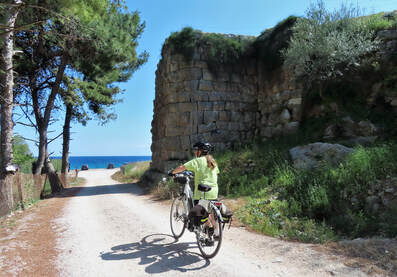
In the afternoon it was an easy ride west for 5 km to the incongruous seaside resort of Tolo. The tourists had not yet descended, the main road was closed for resurfacing, the children’s amusement park was shut, campsites and hotels empty. We did find an ice cream café run by a Greek Cypriot who had once lived near Cheltenham, working at a fish & chip shop owned by his in-laws! He agreed there was nothing like it in Greece! On the way back we had a look at the remains of the acropolis of Ancient Asini overlooking the water (entry 3 Euros, or 2 Euros for EU citizens aged over 65: another penalty of Brexit, if you’re honest!)
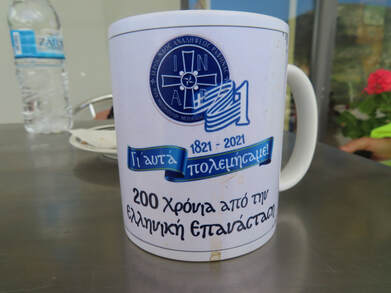
Day Sixty-five 9 miles driven
To Camping Iria Beach, Iria, Argolis, Greek Peloponnese
Just a short drive to relocate to Iria Beach, the base for a long circular ride tomorrow. The weather was perfect, with all the laundry line-dried in an hour before leaving. A parting gift from Christina was a bag full of 18 hand-picked lemons from her orchard, meaning more lemon curd and cakes to come!
Day Sixty-six
At Camping Iria Beach, Iria, Argolis, Greek Peloponnese
Cycling a 58-km Anticlockwise Circuit in the Foothills of Mavrovouni
After a few level miles northeast between richly sown fields, we joined a minor road to Karnezaika, then climbed steep hairpins to over 330 m (1,000 ft), past semi-abandoned villages, each with a church and a few shuttered cottages. At 20 km we met the much busier main road and turned north for 5 km to Tracheia, a larger village famed for its local cheeses. The south-bound traffic from Corinth or even Athens was continuous, heading to the coast at Kranidi, Portoheli or perhaps the Saronic islands of Spetses or Hydra, this being the Saturday of the May Day long weekend. At the third attempt (one café closed, the next saying ‘no coffee’) we sat outside a cheese and pasta emporium with mugs of excellent cappuccino and home-made orange biscuits: a gift from the delightful woman in the bakery!
To Camping Iria Beach, Iria, Argolis, Greek Peloponnese
Just a short drive to relocate to Iria Beach, the base for a long circular ride tomorrow. The weather was perfect, with all the laundry line-dried in an hour before leaving. A parting gift from Christina was a bag full of 18 hand-picked lemons from her orchard, meaning more lemon curd and cakes to come!
Day Sixty-six
At Camping Iria Beach, Iria, Argolis, Greek Peloponnese
Cycling a 58-km Anticlockwise Circuit in the Foothills of Mavrovouni
After a few level miles northeast between richly sown fields, we joined a minor road to Karnezaika, then climbed steep hairpins to over 330 m (1,000 ft), past semi-abandoned villages, each with a church and a few shuttered cottages. At 20 km we met the much busier main road and turned north for 5 km to Tracheia, a larger village famed for its local cheeses. The south-bound traffic from Corinth or even Athens was continuous, heading to the coast at Kranidi, Portoheli or perhaps the Saronic islands of Spetses or Hydra, this being the Saturday of the May Day long weekend. At the third attempt (one café closed, the next saying ‘no coffee’) we sat outside a cheese and pasta emporium with mugs of excellent cappuccino and home-made orange biscuits: a gift from the delightful woman in the bakery!
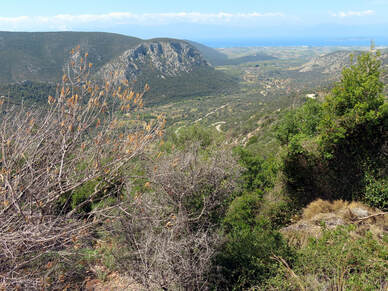
Once out of Tracheia, it was a relief to turn off the Corinth road and climb westwards, through wild uninhabited country rising to 400 m. Along the way a remote church dedicated to Agios Nikolaus proved a good spot for a break, while deciphering the Greek names on the murals: male saints along one side, females opposite, an archangel to each side of Christ and his disciples along the end wall: the standard Orthodox iconography. I lit two candles to ensure an ‘ασφαλές και καλό ταξίδι’ (safe and good journey) and we continued on our way through the hills. Past the village of Adami we soon turned off southwest on a rougher path, up and down, meeting only a goatherd and her animals. Eventually it dropped steeply past stone quarries to the coast at Kantia, for an easier mile or two back to Iria Beach. A very satisfying ride, rekindling memories of completing the route many years ago on (non-electric) touring cycles. The campsite guardian (who spoke only Greek) rewarded us with a giant lettuce, though he could not imagine where we’d been.
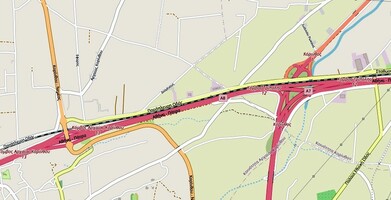
Day Sixty-seven 89 miles driven
To Camping Akrata Beach, Akrata, Achaea, Greek Peloponnese
Away early Sunday morning, fearing traffic jams which didn’t occur. We bypassed any congestion in Drepano, Nafplio or Argos by taking a good road north and west from Kantia, past Agios Andreas and Nea Tirintha, across the orange-growing Argolid plain. After climbing to 350 m near Mycenae-of-ancient-memory, we crossed the defunct railway line and almost missed the sharp, unlikely and unsigned left turn towards the A7 motorway junction near Nemea, bound for Corinth.
We passed a toll booth (Class 3, Euros 5.80) and an empty service station with a view of Acrocorinth Castle perched on its 575 m rock high above Ancient Corinth: both magnificent sites that we’ve visited more than once. Joining the A8 motorway from Athens seemed unnecessarily complicated but eventually we were on the way towards Patras (more tolls). From the Akrata exit it’s just a couple of miles on the old national road through Akrata, over a bridge, then along a very narrow lane beside a dry riverbed to the campsite on the stony shore of the Gulf of Corinth. The site and its small restaurant are run by a Greek-Australian couple who eventually found us a pitch where the Wifi worked. That may be useful, as rain is forecast.
To Camping Akrata Beach, Akrata, Achaea, Greek Peloponnese
Away early Sunday morning, fearing traffic jams which didn’t occur. We bypassed any congestion in Drepano, Nafplio or Argos by taking a good road north and west from Kantia, past Agios Andreas and Nea Tirintha, across the orange-growing Argolid plain. After climbing to 350 m near Mycenae-of-ancient-memory, we crossed the defunct railway line and almost missed the sharp, unlikely and unsigned left turn towards the A7 motorway junction near Nemea, bound for Corinth.
We passed a toll booth (Class 3, Euros 5.80) and an empty service station with a view of Acrocorinth Castle perched on its 575 m rock high above Ancient Corinth: both magnificent sites that we’ve visited more than once. Joining the A8 motorway from Athens seemed unnecessarily complicated but eventually we were on the way towards Patras (more tolls). From the Akrata exit it’s just a couple of miles on the old national road through Akrata, over a bridge, then along a very narrow lane beside a dry riverbed to the campsite on the stony shore of the Gulf of Corinth. The site and its small restaurant are run by a Greek-Australian couple who eventually found us a pitch where the Wifi worked. That may be useful, as rain is forecast.
Day Sixty-eight
At Camping Akrata Beach, Akrata, Achaea, Greek Peloponnese
May Day, a public holiday in Greece and (as is traditional in the UK) it rained, with storms forecast! The Greek campers returned home and we reluctantly abandoned any plan to cycle up the gorge to the mountainside village of Zarouchia. Looking ahead to leaving the Peloponnese, we checked out the car ferry once taken across the Gulf of Corinth (Egio to Agios Nikolaos). Sadly it has not run for several years, so a longer journey over the Rio-Antirrio Bridge is the only option.
I baked a lemon drizzle loaf and made lemon curd, using up three of Christina’s 18 lemons! Now, what can I do with a mega-lettuce?
At Camping Akrata Beach, Akrata, Achaea, Greek Peloponnese
May Day, a public holiday in Greece and (as is traditional in the UK) it rained, with storms forecast! The Greek campers returned home and we reluctantly abandoned any plan to cycle up the gorge to the mountainside village of Zarouchia. Looking ahead to leaving the Peloponnese, we checked out the car ferry once taken across the Gulf of Corinth (Egio to Agios Nikolaos). Sadly it has not run for several years, so a longer journey over the Rio-Antirrio Bridge is the only option.
I baked a lemon drizzle loaf and made lemon curd, using up three of Christina’s 18 lemons! Now, what can I do with a mega-lettuce?
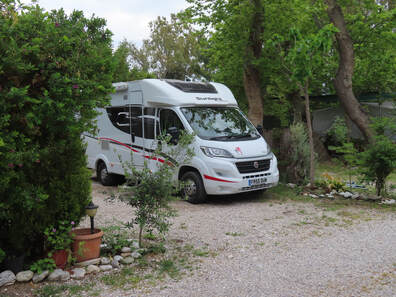
Day Sixty-nine 106 miles driven
To Delphi Camping, Delphi, Central Greece
Leaving the Peloponnese
The weather remained showery with strong winds. As we manoeuvred out of Akrata Beach, a large German motorhome collided with the campsite boss’s Mercedes parked outside his restaurant. The very definition of Schadenfreude! Then we followed a Bulgarian (hired) camper along the narrow lane and into the centre of Akrata, where it turned the wrong way down a cul-de-sac. Easily done.
To Delphi Camping, Delphi, Central Greece
Leaving the Peloponnese
The weather remained showery with strong winds. As we manoeuvred out of Akrata Beach, a large German motorhome collided with the campsite boss’s Mercedes parked outside his restaurant. The very definition of Schadenfreude! Then we followed a Bulgarian (hired) camper along the narrow lane and into the centre of Akrata, where it turned the wrong way down a cul-de-sac. Easily done.
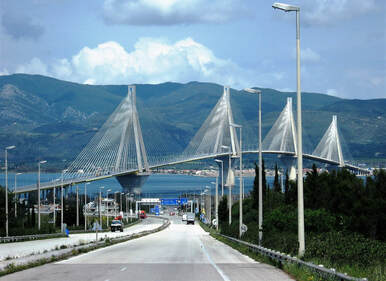
Regaining the A8/E65/Olympia Odos toll-motorway towards Patras, it was an easier 40-mile journey to a badly signed exit for the impressive Rio-Antirrio bridge across the Gulf of Corinth (toll 21 Euros). Claiming to be the longest cable-stayed bridge in the world, it was completed in 2004 at the time of the Athens Olympics. We well remember a cartoon at the time, showing an Olympic torch-bearer preparing to jump the central gap of the unfinished structure!
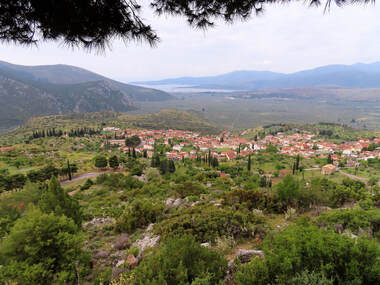
Once across, we turned east on E65 (not a motorway) following the north shore of the Gulf. I made the mistake of directing us through the Nafpaktos, rather than bypassing the busy town on an inland route. It proved impossible to park at Lidl or any other supermarket we passed, while the narrow streets, parked cars and roadworks all but blocked the way past the medieval harbour, Venetian castle and old mosque. At 50 miles we thankfully rejoined the E65 and followed the coastal road (signed Amfissa) overlooking villages with small harbours, like Glifada, Ag Nikolaos (the late-lamented ferry port) and Galaxidi.
At the small waterfront town of Itea we turned north to climb about 400 m (1300 ft) in the final 6 miles, ending with a couple of steep Z-bends, before reaching the campsite about 4 miles below Delphi. It was pouring with rain as we settled in under the dripping pine trees, with a misty view of the ‘Sea of Olives’ spilling down to the coast.
At the small waterfront town of Itea we turned north to climb about 400 m (1300 ft) in the final 6 miles, ending with a couple of steep Z-bends, before reaching the campsite about 4 miles below Delphi. It was pouring with rain as we settled in under the dripping pine trees, with a misty view of the ‘Sea of Olives’ spilling down to the coast.
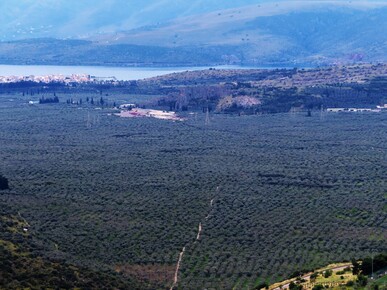
Day Seventy
At Delphi Camping, Delphi, Central Greece
The Mer des Oliviers de Delphe
The site proudly sells its own olives and extra virgin cold-pressed oil “bottled in March 2023, so it can be consumed without fear until October 2024”. Indeed the ancient olive groves of Amfissa (the Sea of Olives), claiming to be over 3000 years old, were the first to produce oil in Greece. We were duly impressed by the expansive view of the silvery-green trees below, but less impressed by the climate: still raining, with some thunder and hail.
This marked the end of our 60-day tour of the Peloponnese, our favourite part of Greece, where we camped in 10 places, drove 760 miles (1,215 km) by motorhome and cycled 780 miles (1,250 km)!
At Delphi Camping, Delphi, Central Greece
The Mer des Oliviers de Delphe
The site proudly sells its own olives and extra virgin cold-pressed oil “bottled in March 2023, so it can be consumed without fear until October 2024”. Indeed the ancient olive groves of Amfissa (the Sea of Olives), claiming to be over 3000 years old, were the first to produce oil in Greece. We were duly impressed by the expansive view of the silvery-green trees below, but less impressed by the climate: still raining, with some thunder and hail.
This marked the end of our 60-day tour of the Peloponnese, our favourite part of Greece, where we camped in 10 places, drove 760 miles (1,215 km) by motorhome and cycled 780 miles (1,250 km)!
Northern Greece to Bulgaria
Delphi to Stylida, Camping Interstation 70 miles
After driving north from Delphi via Amfissa, in the foothills of the Parnassos mountains, we joined the A1 toll motorway near Thermopyles. These ‘Hot Gates’ are famed for the battle in which Xerxes and the Persians defeated Leonidas and his Spartan army – and more recently for the thermal spring complex and steaming stream.
Past Lamia we took the exit for Stylida and followed the national road through the town to a familiar all-year campsite by the beach, run by an amiable old guardian who is deaf, speaks a little German, takes no details and accepts only cash-no-receipt. The site facilities are dreadfully neglected: no hot water; toilets devoid of seats, paper or soap; restaurant closed; WiFi unavailable. Perhaps things are different in high season, but it does provide a quiet and secure night, with electricity and a convenient BP petrol station/cafe over the road. We once spent a peaceful Christmas there!
Stylida to Nea Karvali (Near Kavala), Camping Alexandros 275 miles
A few miles east along the national road to Raches, to seamlessly rejoin the A1 motorway and turn north. It was very quiet on this Sunday morning, past Larissa and Volos, with regular tolls deterring local traffic (we paid a total of 51 Euros today!) New tunnels bypassed the Vale of Tempi, with just a glimpse of the Athens-Thessalonika railway line that was the scene of a horrific train crash back in March. Continuing north between sea and mountains, we saw snow lingering atop Mount Olympos until the peaks disappeared under brooding black clouds and rain fell.
After crossing the Axios River we joined the A2, the Ignatia Odos (named after the Roman Via Egnatia from Durres in modern-day Albania to Constantinople/Istanbul). It took us round the congested sprawl of Greece’s second city, Thessalonika, then east across (Greek) Macedonia. The more recently completed section of the motorway to the Turkish border has no service stations at all, just occasional rest areas with toilets. Lunch break in a parking area on the north side of Lake Koroneia, then on past Lake Volvi and the Asprovolta exit (handy for fuel and Lidl if needed, but not today). The motorway kept high above the coast road, through a couple of tunnels, reaching over 1,000 ft (315 m) near Kavala before dropping to sea level.
From the exit for Nea Karvali, we headed 2 miles down to the sea and a campsite we’d not used before: the Alexandros Restaurant and Camping. Suffice to say, we won’t be using it again! We did get a place to park outside the restaurant with a hook-up but the emphasis is on the rooms and restaurant rather than on camping facilities or a friendly reception. The owner ‘Mrs Maria’ claimed the right to keep my passport until we left because “campers leave without paying” (I had tried to pay her assistant on arrival but she didn’t know the price). Mrs Maria further explained there was no soap or toilet paper or hot water for washing up because “campers steal it”. She also demanded the highest price so far this year, though she didn’t get it after considerable argument. We were almost as glad to leave next morning as she was to see us go!
Nea Karvali, Greece to Camping Sakar Hills, Biser, Bulgaria 208 miles
Back to the A2 toll motorway and ever eastward, past Megas Alexandros airport, the offshore island of Thassos scarcely visible in the mist. Entering Thrace the villages looked poorer and the flat plain was sown with rice and tobacco, while a dozen storks grazed the fields. Minarets graced the skyline in the towns of Xanthi and Komotini, in the shadow of the Rhodope mountains. I still wonder why a small tortoise was trying to cross 4 lanes of traffic there and whether it made it to the other side.
We continued along A2 past Alexandroupolis, having vowed that last year’s miserable experience at its vast municipal campsite would be the last. We left the motorway at 105 miles, some 6 miles before the Turkish border, paying our final toll. Then it was north on the wide quiet road 51, past Soufli, turning off 43 miles later at Didimoticho North for a shopping and lunch break at Lidl – less than a mile off the route with easy parking. Back to Road 51 continuing north along the country’s eastern border with Turkey, formed by the River Evros, past Oradea (the last town in Greece).
And so to the Greek-Bulgarian border by Ormenio at 193 miles. The Greek guard scrutinised our passports for the vital date that we entered the Schengen zone, then counted on his fingers to check the length of our stay (81 days) before duly stamping the passports with the exit date – no evidence of computerised records yet. Then through a no-man’s land and a disinfectant trough before entering non-Schengen (for now) Bulgaria. Here the guard stamped the passports, a customs official checked our garage, and I bought the electronic Vignette needed for all Bulgarian roads from a machine which charged 27 lev for one month (2 lev = 1 Euro). What a relief – no more counting the days for now.
Delphi to Stylida, Camping Interstation 70 miles
After driving north from Delphi via Amfissa, in the foothills of the Parnassos mountains, we joined the A1 toll motorway near Thermopyles. These ‘Hot Gates’ are famed for the battle in which Xerxes and the Persians defeated Leonidas and his Spartan army – and more recently for the thermal spring complex and steaming stream.
Past Lamia we took the exit for Stylida and followed the national road through the town to a familiar all-year campsite by the beach, run by an amiable old guardian who is deaf, speaks a little German, takes no details and accepts only cash-no-receipt. The site facilities are dreadfully neglected: no hot water; toilets devoid of seats, paper or soap; restaurant closed; WiFi unavailable. Perhaps things are different in high season, but it does provide a quiet and secure night, with electricity and a convenient BP petrol station/cafe over the road. We once spent a peaceful Christmas there!
Stylida to Nea Karvali (Near Kavala), Camping Alexandros 275 miles
A few miles east along the national road to Raches, to seamlessly rejoin the A1 motorway and turn north. It was very quiet on this Sunday morning, past Larissa and Volos, with regular tolls deterring local traffic (we paid a total of 51 Euros today!) New tunnels bypassed the Vale of Tempi, with just a glimpse of the Athens-Thessalonika railway line that was the scene of a horrific train crash back in March. Continuing north between sea and mountains, we saw snow lingering atop Mount Olympos until the peaks disappeared under brooding black clouds and rain fell.
After crossing the Axios River we joined the A2, the Ignatia Odos (named after the Roman Via Egnatia from Durres in modern-day Albania to Constantinople/Istanbul). It took us round the congested sprawl of Greece’s second city, Thessalonika, then east across (Greek) Macedonia. The more recently completed section of the motorway to the Turkish border has no service stations at all, just occasional rest areas with toilets. Lunch break in a parking area on the north side of Lake Koroneia, then on past Lake Volvi and the Asprovolta exit (handy for fuel and Lidl if needed, but not today). The motorway kept high above the coast road, through a couple of tunnels, reaching over 1,000 ft (315 m) near Kavala before dropping to sea level.
From the exit for Nea Karvali, we headed 2 miles down to the sea and a campsite we’d not used before: the Alexandros Restaurant and Camping. Suffice to say, we won’t be using it again! We did get a place to park outside the restaurant with a hook-up but the emphasis is on the rooms and restaurant rather than on camping facilities or a friendly reception. The owner ‘Mrs Maria’ claimed the right to keep my passport until we left because “campers leave without paying” (I had tried to pay her assistant on arrival but she didn’t know the price). Mrs Maria further explained there was no soap or toilet paper or hot water for washing up because “campers steal it”. She also demanded the highest price so far this year, though she didn’t get it after considerable argument. We were almost as glad to leave next morning as she was to see us go!
Nea Karvali, Greece to Camping Sakar Hills, Biser, Bulgaria 208 miles
Back to the A2 toll motorway and ever eastward, past Megas Alexandros airport, the offshore island of Thassos scarcely visible in the mist. Entering Thrace the villages looked poorer and the flat plain was sown with rice and tobacco, while a dozen storks grazed the fields. Minarets graced the skyline in the towns of Xanthi and Komotini, in the shadow of the Rhodope mountains. I still wonder why a small tortoise was trying to cross 4 lanes of traffic there and whether it made it to the other side.
We continued along A2 past Alexandroupolis, having vowed that last year’s miserable experience at its vast municipal campsite would be the last. We left the motorway at 105 miles, some 6 miles before the Turkish border, paying our final toll. Then it was north on the wide quiet road 51, past Soufli, turning off 43 miles later at Didimoticho North for a shopping and lunch break at Lidl – less than a mile off the route with easy parking. Back to Road 51 continuing north along the country’s eastern border with Turkey, formed by the River Evros, past Oradea (the last town in Greece).
And so to the Greek-Bulgarian border by Ormenio at 193 miles. The Greek guard scrutinised our passports for the vital date that we entered the Schengen zone, then counted on his fingers to check the length of our stay (81 days) before duly stamping the passports with the exit date – no evidence of computerised records yet. Then through a no-man’s land and a disinfectant trough before entering non-Schengen (for now) Bulgaria. Here the guard stamped the passports, a customs official checked our garage, and I bought the electronic Vignette needed for all Bulgarian roads from a machine which charged 27 lev for one month (2 lev = 1 Euro). What a relief – no more counting the days for now.
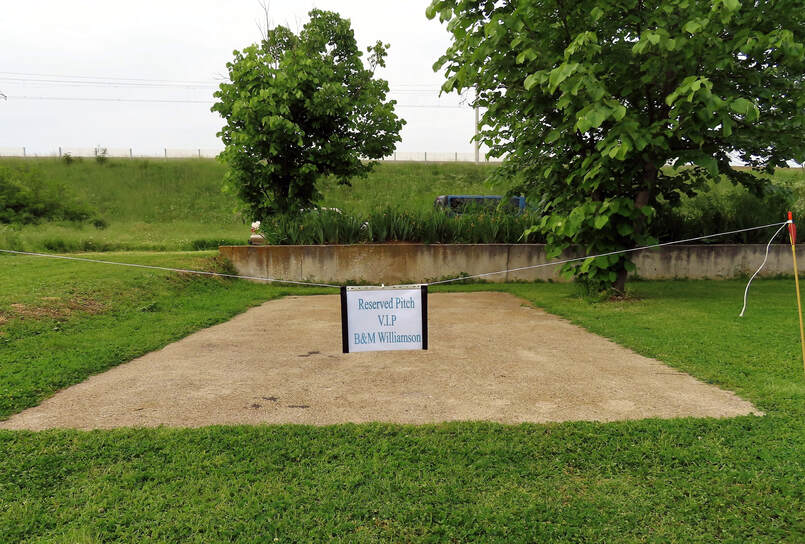
Just 15 familiar Bulgarian miles via Ljubimets to the village of Biser and the welcome sanctuary of Sakar Hills Camping, less than a mile off the main road, owned and run by the inimitable Jeffes family. Here we were expected and warmly greeted by managing son Matt. Time to relax.
Continued at Margaret's Travel Log: Bulgaria